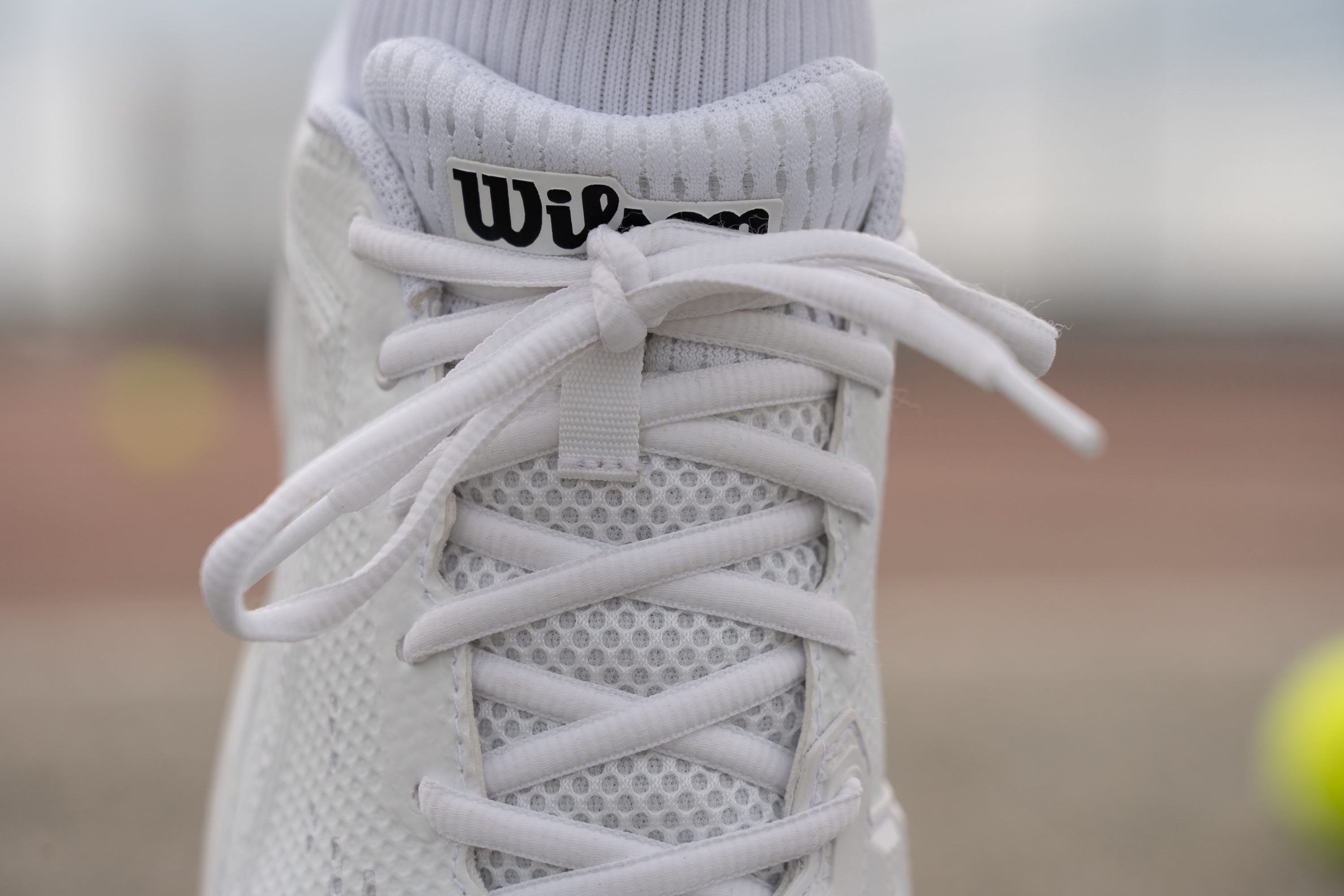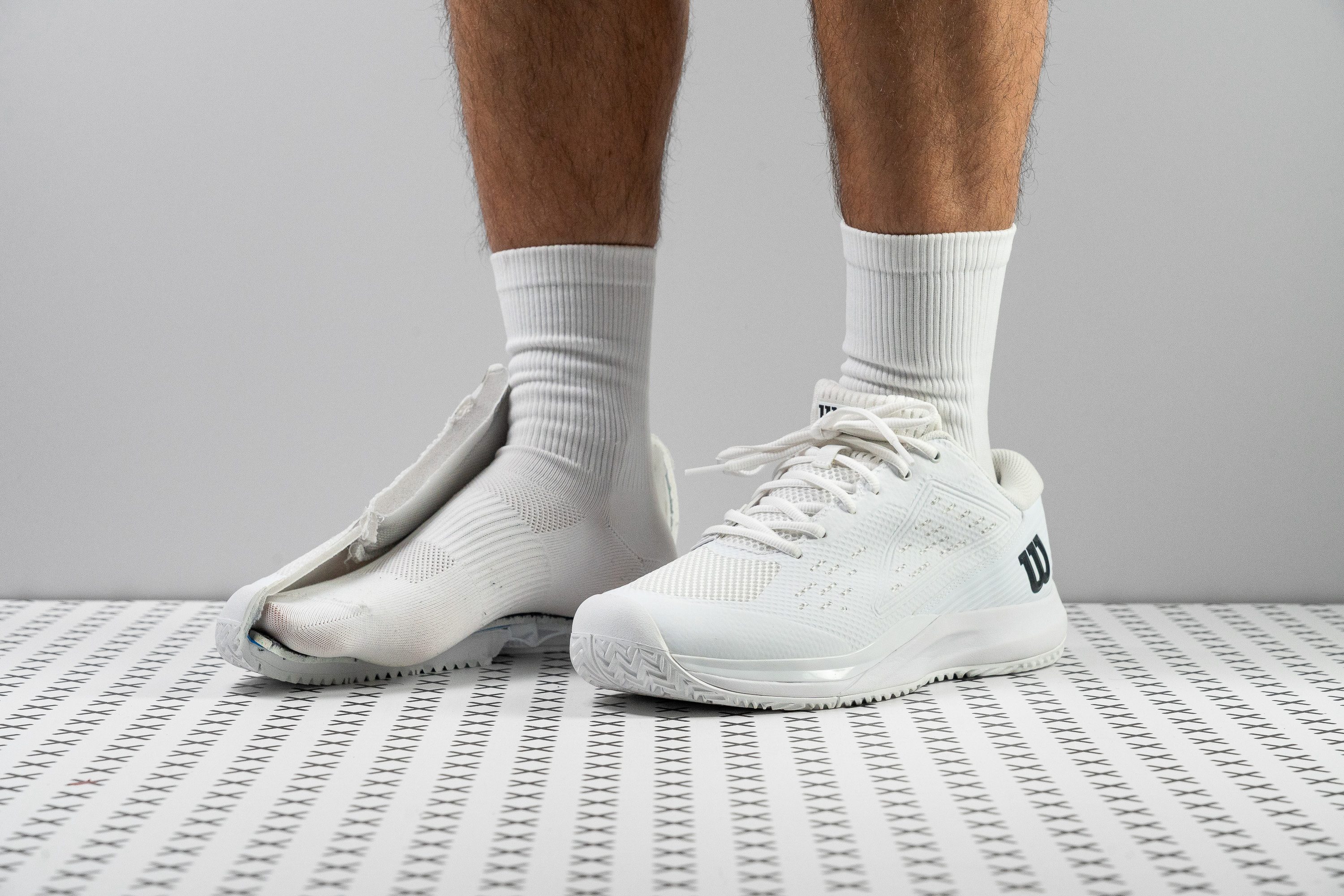Nuestra conclusión
Pros
- Muy buena relación calidad-precio
- Buena sujeción lateral y estabilidad
- Buena protección contra impactos
- Caucho muy duradero para su precio
- Suela exterior con buen agarre que te deja deslizarte
- Parte delantera espaciosa
- Interior cómodo y acolchado
Contras
- Poco transpirables
- Cordones y upper con materiales frágiles
Veredicto de los usuarios
Comparativa
Las zapatillas de tenis más parecidas
+ + Añadir unas zapatillas | |||||
|---|---|---|---|---|---|
| Puntuación global | 88 Notables | 86 Notables | 86 Notables | 83 Buenas | |
| Precio | 110 € | 150 € | 120 € | 80 € | |
| Tipo de calzado | Todas las superficies | Todas las superficiesPista dura | Todas las superficiesPista dura | Todas las superficies | |
| Diseño | Velocidad | Estabilidad | Velocidad | Estabilidad | |
| Transpirabilidad | Media | Baja | Media | Media | |
| Peso laboratorio | 12.6 oz / 357g | 12.9 oz / 367g | 12.2 oz / 347g | 12.8 oz / 363g | |
| Lightweight | ✗ | ✗ | ✓ | ✗ | |
| Drop laboratorio | 9.4 mm | 9.1 mm | 11.8 mm | 9.5 mm | |
| Anchura / ajuste | Media | Media | Media | Ancha | |
| Anchura de la parte delantera | Ancha | Media | Media | Media | |
| Talla | Tallan bien | Tallan bien | Tallan bien | Media talla más pequeñas | |
| Rigidez de la mediasuela | Equilibrada | Equilibrada | Equilibrada | Equilibrada | |
| Flexibilidad | Moderada | Firme | Flexible | Moderada | |
| Rigidez torsional | Moderadas | Moderadas | Moderadas | Firmes | |
| Rigidez del contrafuerte del talón | Moderadas | Firmes | Moderadas | Moderadas | |
| Anchura de la mediasuela - antepié | Estándar | Estándar | Estándar | Estándar | |
| Anchura de la mediasuela - talón | Estándar | Estándar | Estándar | Ancha | |
| Durabilidad de la suela exterior | Decente | Decente | Buena | Decente | |
| Durabilidad del acolchado del talón | Baja | Baja | Alta | Alta | |
| Altura de la suela en la zona del talón laboratorio | 28.9 mm | 29.1 mm | 28.8 mm | 28.5 mm | |
| Antepié | 19.5 mm | 20.0 mm | 17.0 mm | 19.0 mm | |
| Grosor de la plantilla | Fina | Fina | Gruesa | Estándar | |
| Plantilla extraíble | ✓ | ✓ | ✓ | ✓ | |
| Tirador del talón | Ninguno | Ninguno | Talón extendido | Ninguno | |
| Durabilidad de la parte delantera | Decente | Buena | Buena | Buena | |
| Dureza de la suela | Estándar | Estándar | Estándar | Dura | |
| Grosor de la suela | Estándar | Estándar | Fina | Muy gruesa | |
| Clasificación | #14 Top 36% | #18 Top 47% | #17 Top 44% | #23 41% inferior | |
| Popularidad | #18 Top 47% | #37 5% inferior | #21 46% inferior | #9 Top 24% |
Quién debería comprárselas
Las Wilson Rush Pro Ace deberían estar en tu punto de mira si estás buscando:
- Unas zapatillas de iniciación sólidas que no se sientan baratas.
- Una opción muy cómoda y completa para pistas duras.
- Un poquito de espacio extra en la parte delantera de tus zapatillas de tenis.
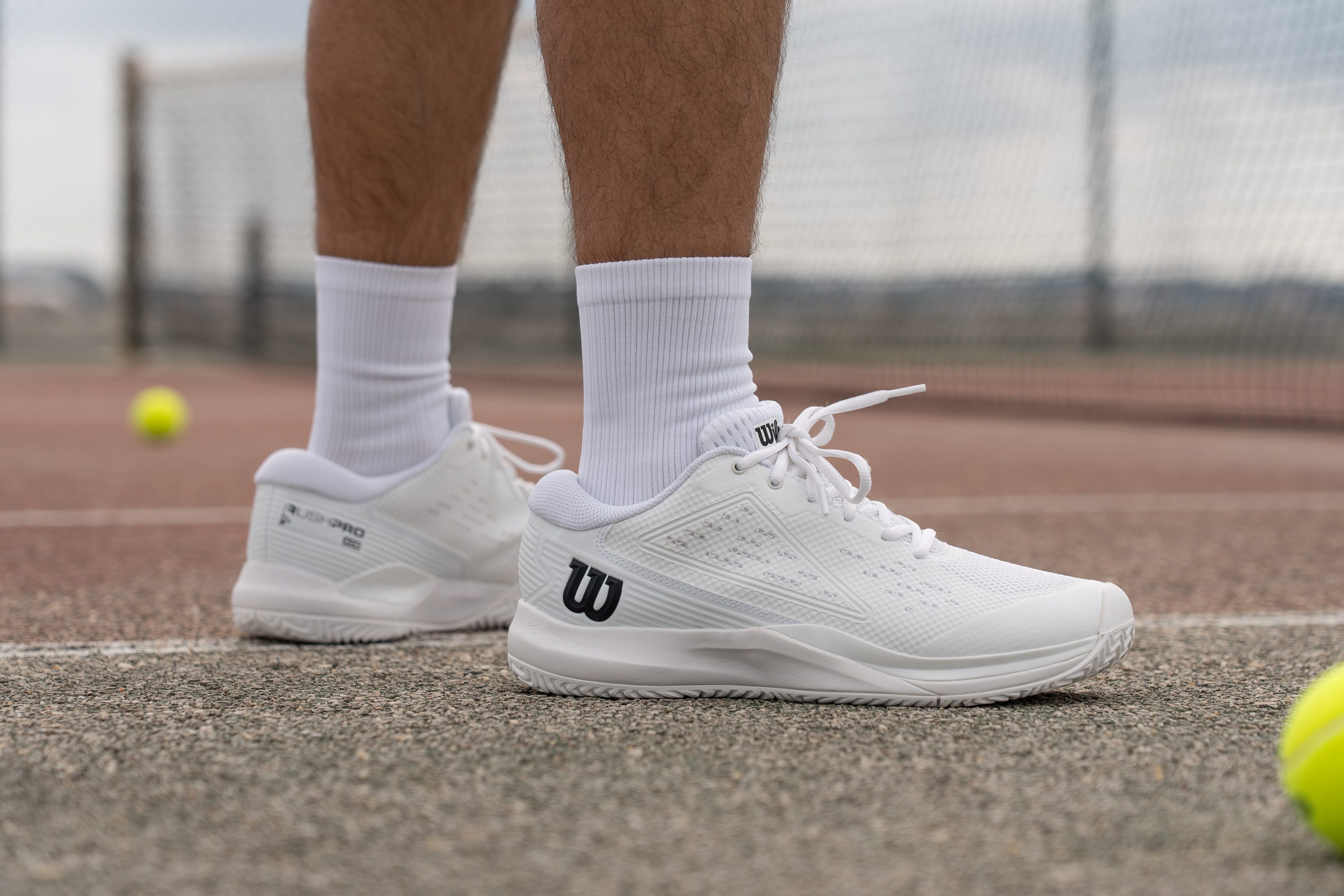
Quién NO debería comprárselas
Es difícil criticar sin pelos en la lengua unas zapatillas económicas que cumplen todos los requisitios básicos y que no tienen ningún punto flojo evidente.
Pero a lo mejor prefieres algo diferente si priorizas:
- La máxima rigidez torsional (no te pierdas las ASICS Gel Challenger 14).
- Todavía más espacio en la parte delantera para pies muy anchos (prueba con las K-Swiss Hypercourt Express 2).
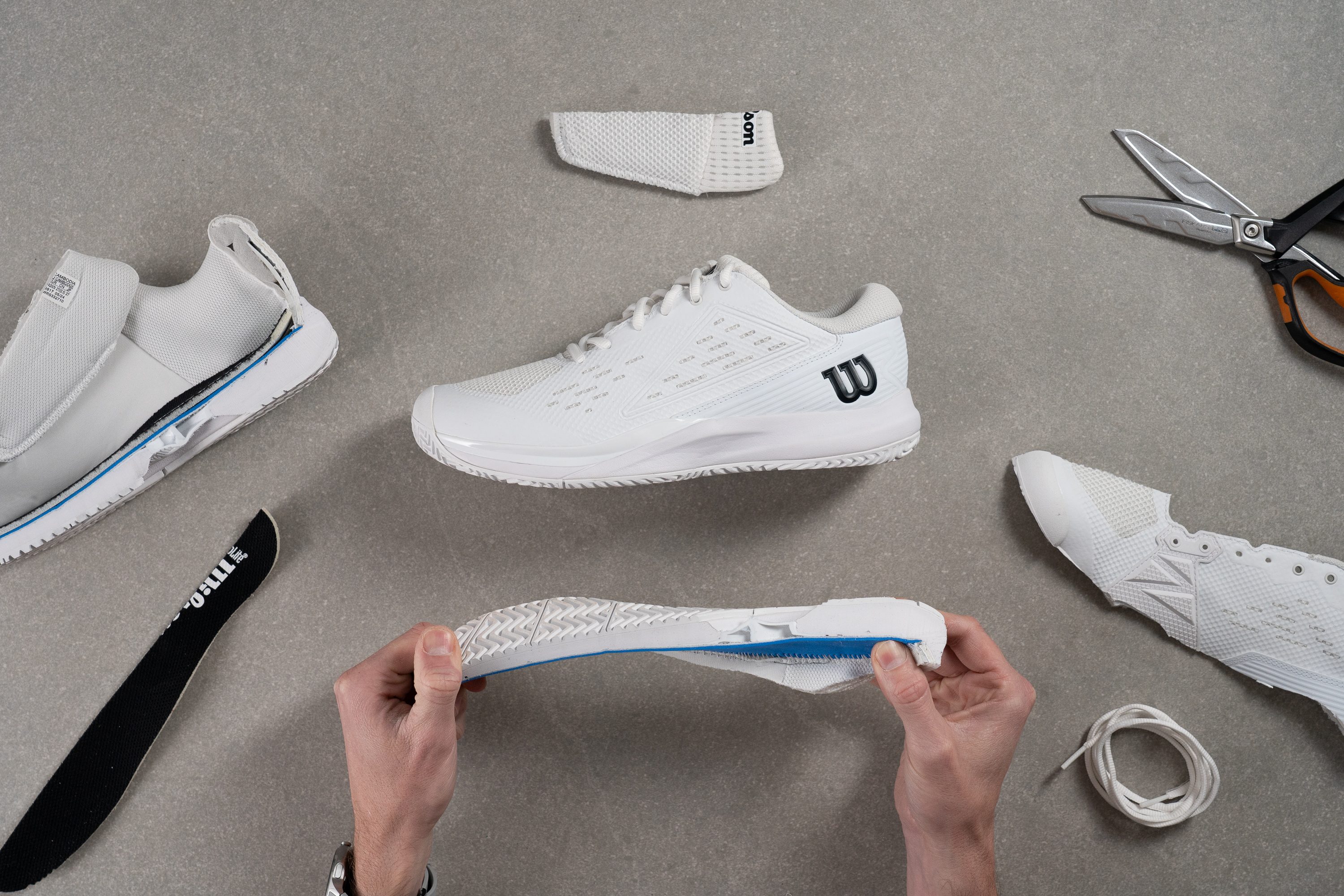
Amortiguación
Shock absorption
Las Wilson Rush Pro Ace ofrecen suficiente protección contra impactos sin ser tan altas como para que te sientas inestable al jugar. Su amortiguación bien equilibrada mostró puntuaciones estándar en nuestra prueba de absorción de impactos: 95 SA en el talón y 58 SA en el antepié.
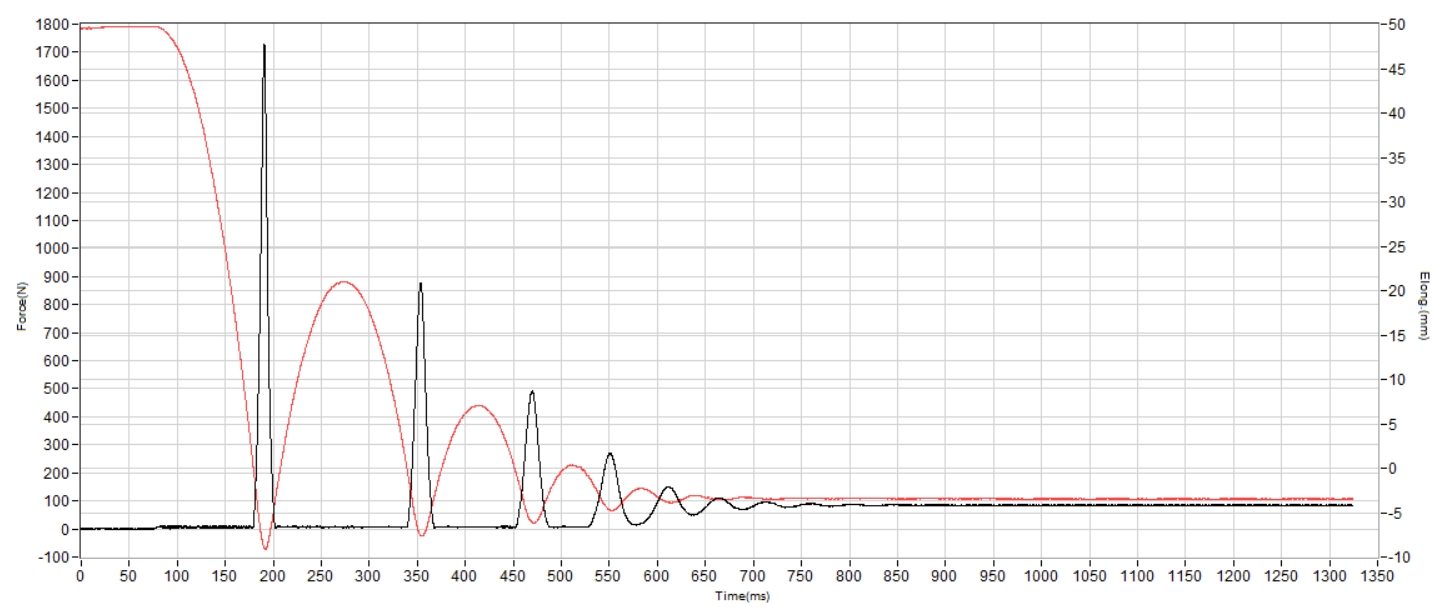
| Rush Pro Ace | 95 SA |
| Media | 99 SA |
Energy return
Las Rush Pro Ace ofrecen un rebote muy moderado, que es algo que vimos claramente en nuestras pruebas de retorno de energía: 46,1 % en el talón y 48,5 % en el antepié.
No es que la pisada sea aburridísima, pero tampoco nos proporcionó mucho impulso.
| Rush Pro Ace | 46.1% |
| Media | 48.8% |
Altura de la suela en la zona del talón
La altura del talón de las Rush Pro Ace está a la par con la media, ya que nuestro calibre marcó 28,9 mm. Es decir, que la suela en esta zona no es ni demasiado alta ni demasiado baja.
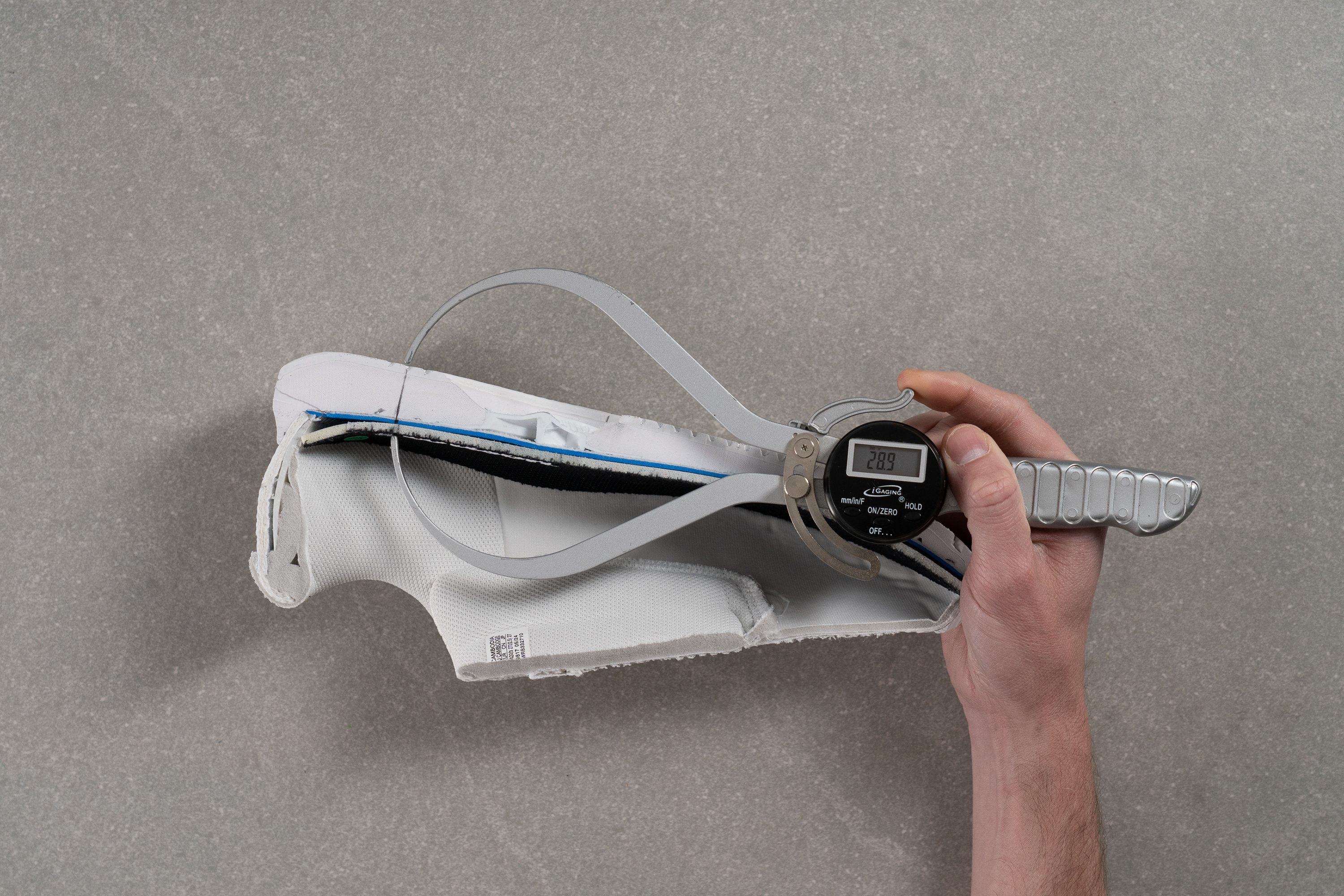
| Rush Pro Ace | 28.9 mm |
| Media | 29.2 mm |
Altura de la suela en el antepié
También hemos medido la suela en el antepié, y el resultado ha vuelto a ser estándar: 19,5 mm. Ofrece una buena conexión con la pista a la vez que mantiene las articulaciones de los dedos y la zona de los metatarsos bien adecuadamente protegidas de los impactos.
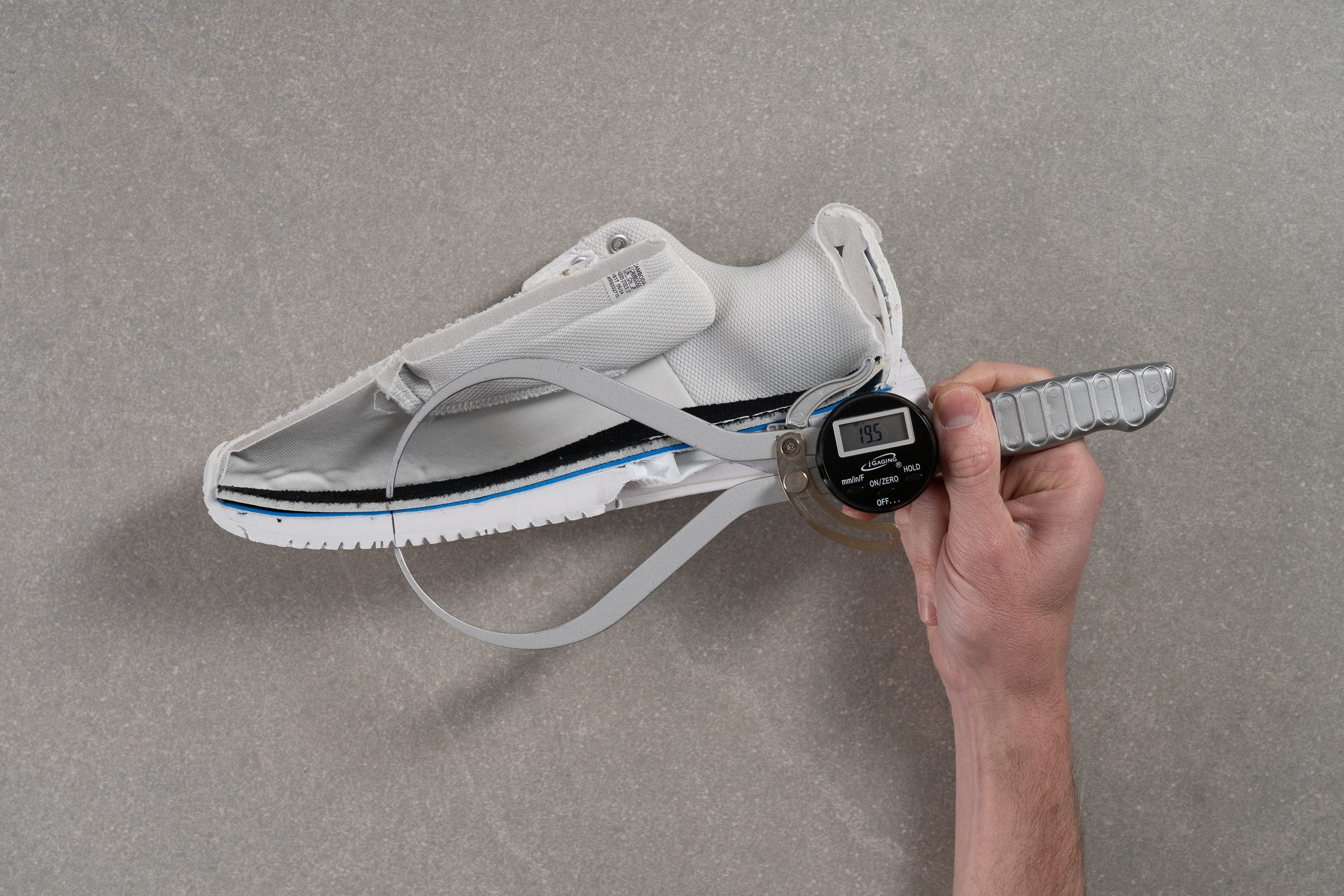
| Rush Pro Ace | 19.5 mm |
| Media | 19.5 mm |
Drop
El drop de 9,4 mm de estas zapatillas de tenis Wilson tampoco fue ninguna sorpresa.
Asegura una colocación equilibrada del pie en la que el talón está un poquito por encima de los dedos. De este modo, el pie recibe la amortiguación necesaria en el talón sin perder el contacto con la pista en el antepié.
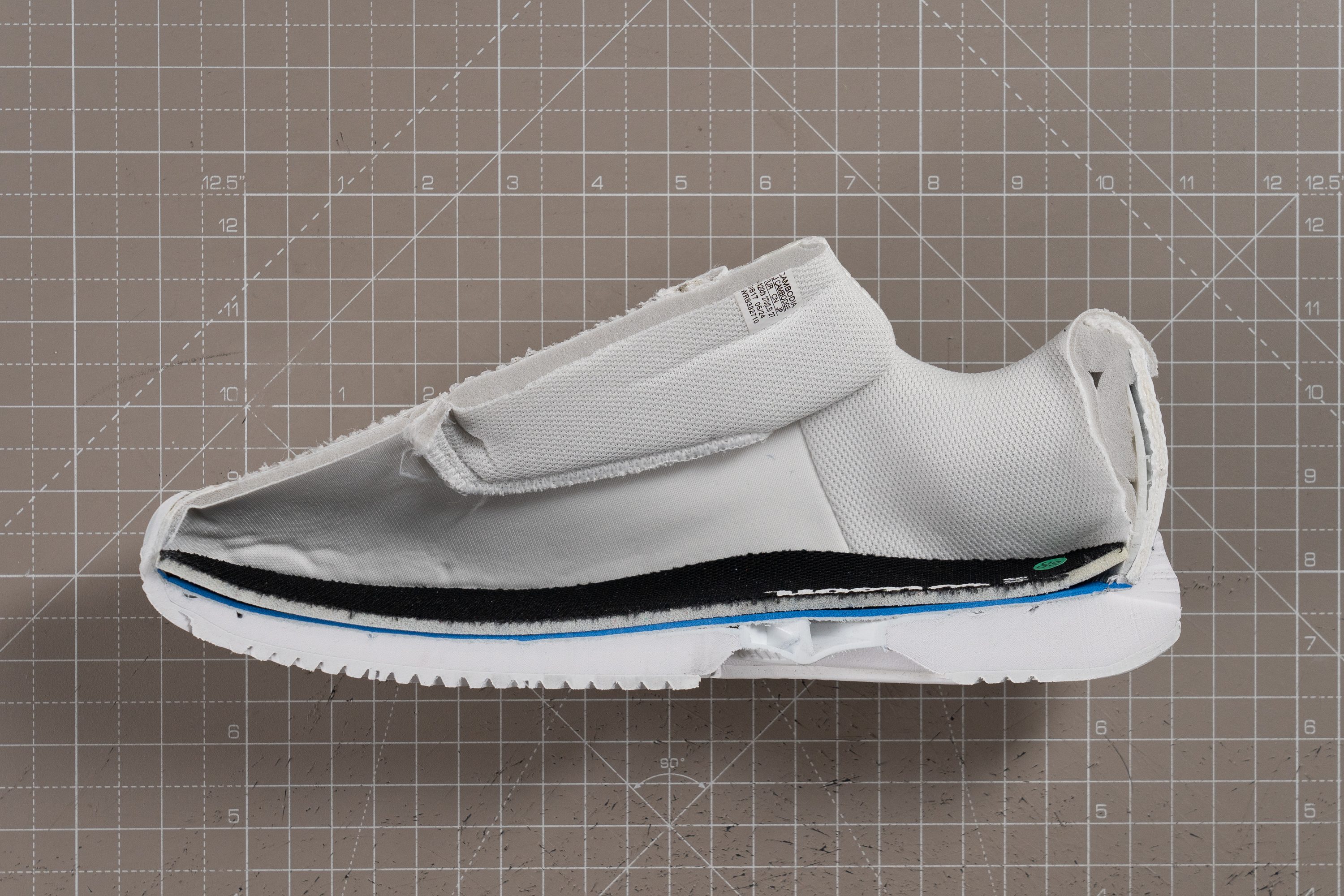
| Rush Pro Ace | 9.4 mm |
| Media | 9.7 mm |
Suavidad de la mediasuela
Según la descripción de la marca, las Rush Pro Ace cuentan con la misma espuma R-DST+ para la amortiguación que las Rush Pro 4.0.
Sin embargo, nuestro durómetro nos indicó que las Ace tienen un compuesto más rígido, ya que marcó un resultado más alto: 27,1 HA, por lo que es un 23 % más firme.
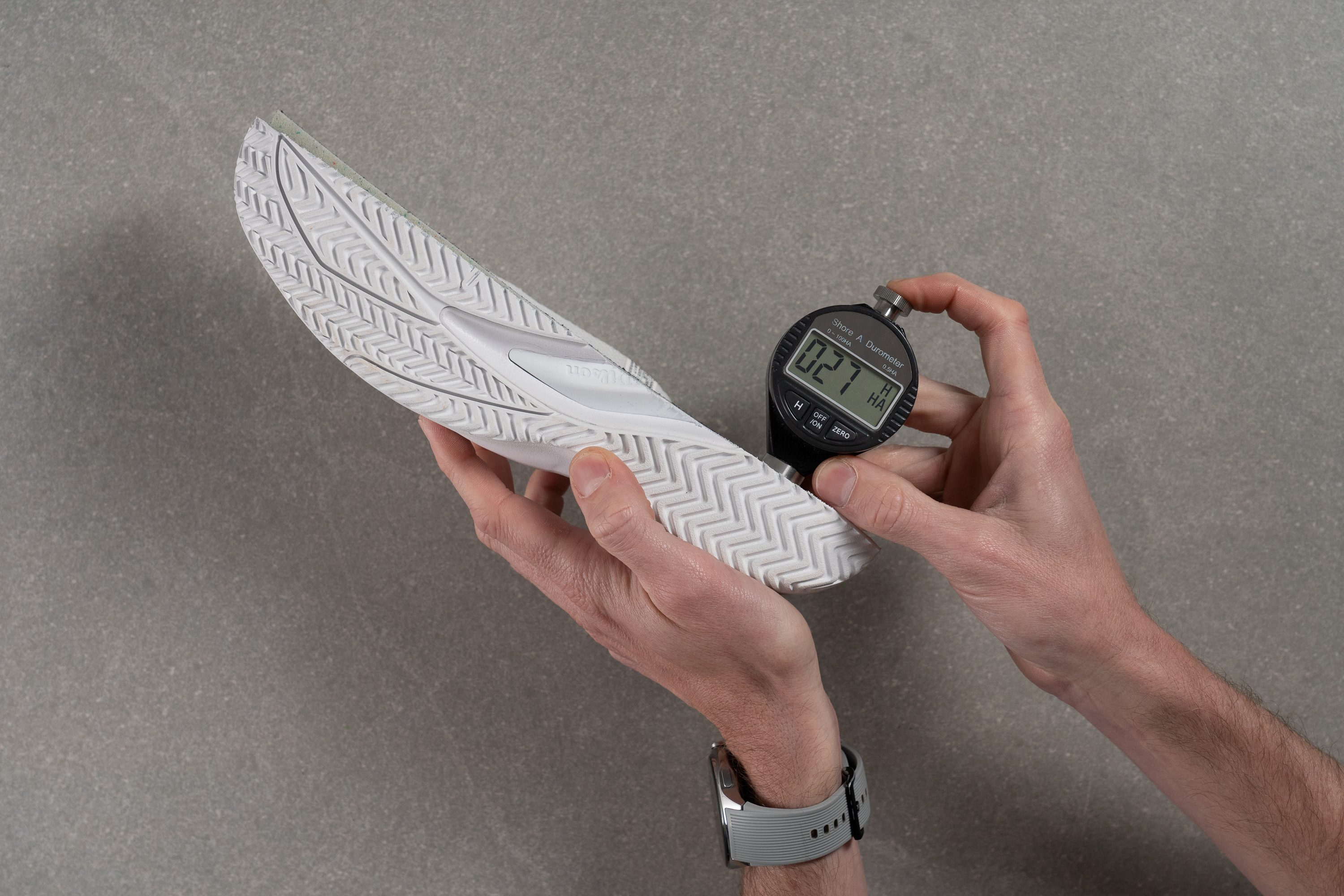
| Rush Pro Ace | 27.1 HA |
| Media | 28.1 HA |
Tallaje y ajuste
Talla
Las Wilson Rush Pro Ace tallan bien (25 votos).
Anchura / Ajuste
Wilson presenta las Rush Pro Ace como unas zapatillas de tenis para pies anchos con una parte delantera más espaciosa. Pero a nosotros nos gusta comprobar estas cosas de manera personal, así que creamos un molde de gel de su interior para ver si era cierto.
Una vez que el molde estuvo listo, cogimos un calibre digital para medir su anchura en la zona más ancha (entre el dedo gordo y el meñique). Imagínate nuestra cara cuando vimos que la herramienta solo marcaba un resultado estándar de 92,7 mm, que es común para las zapatillas de tenis de anchura media que hemos analizado. A ver, entonces, ¿qué es lo que las hace anchas?
Pues el espacio que tienen alrededor de los dedos de los pies.
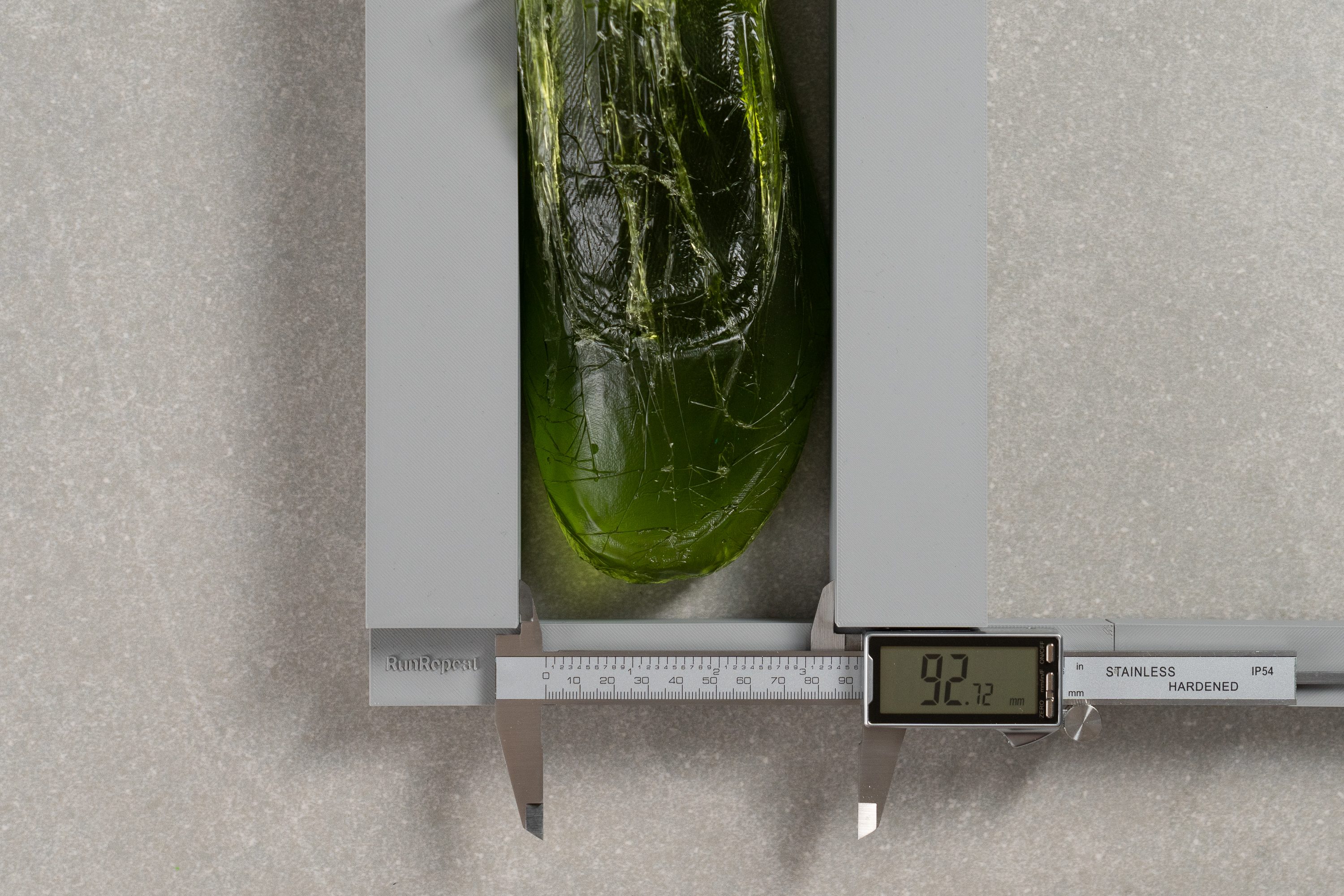
| Rush Pro Ace | 92.7 mm |
| Media | 92.9 mm |
Anchura de la parte delantera
Con solo echarle un ojo al molde, ya podemos decir que las Rush Pro Ace tienen una parte delantera que les deja espacio a los 5 dedos de los pies; y nuestro calibre estuvo totalmente de acuerdo.
Con una anchura superior a la media de 72,7 mm cerca del dedo gordo, estamos ante una de las partes delanteras más anchas que hemos visto hasta la fecha en unas zapatillas de tenis.
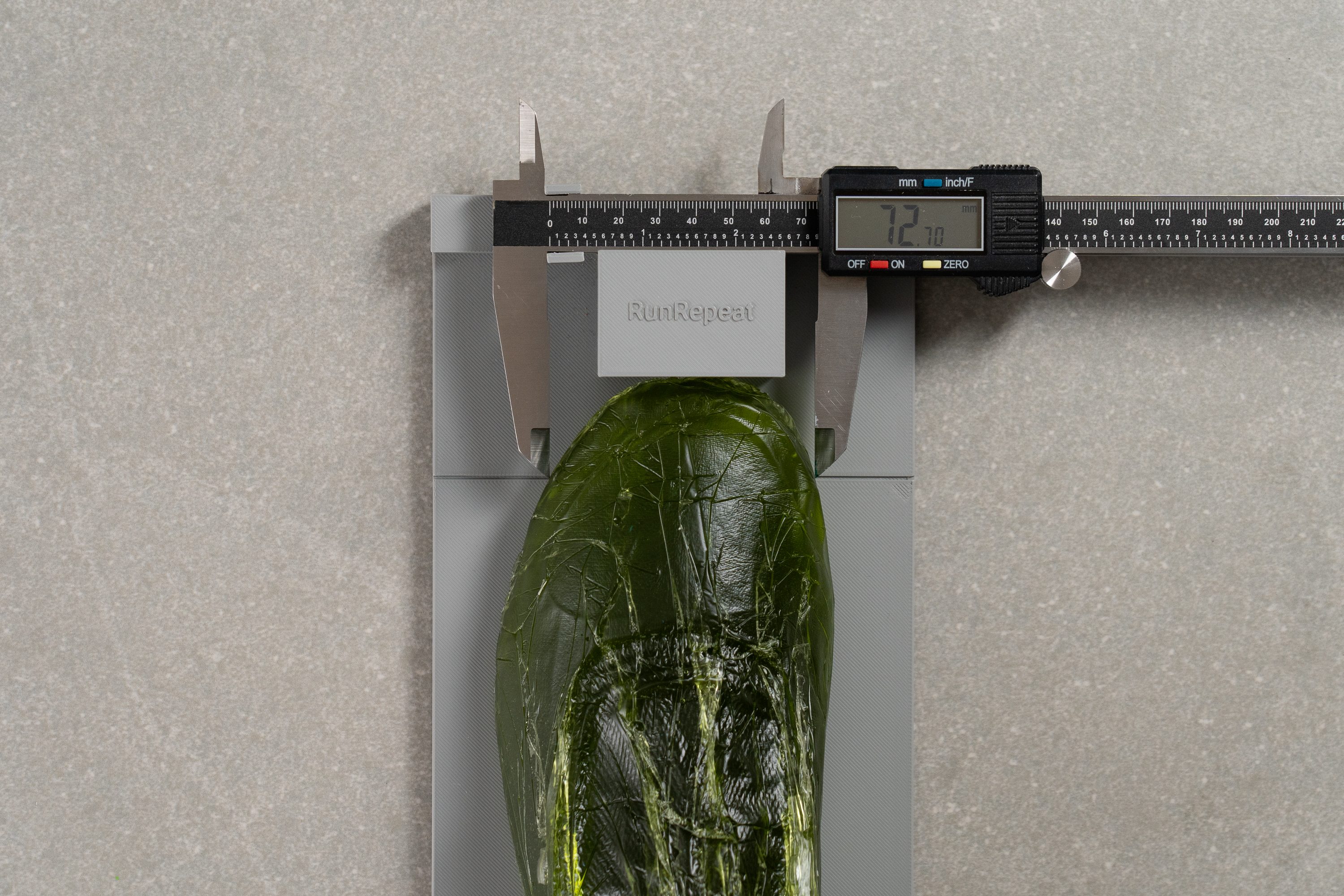
| Rush Pro Ace | 72.7 mm |
| Media | 69.2 mm |
Altura de la parte delantera
Además, su altura alcanza los 27,6 mm, superando por un poquito a la media. Esto hace que el volumen de la parte delantera de las zapatillas aumente incluso más.
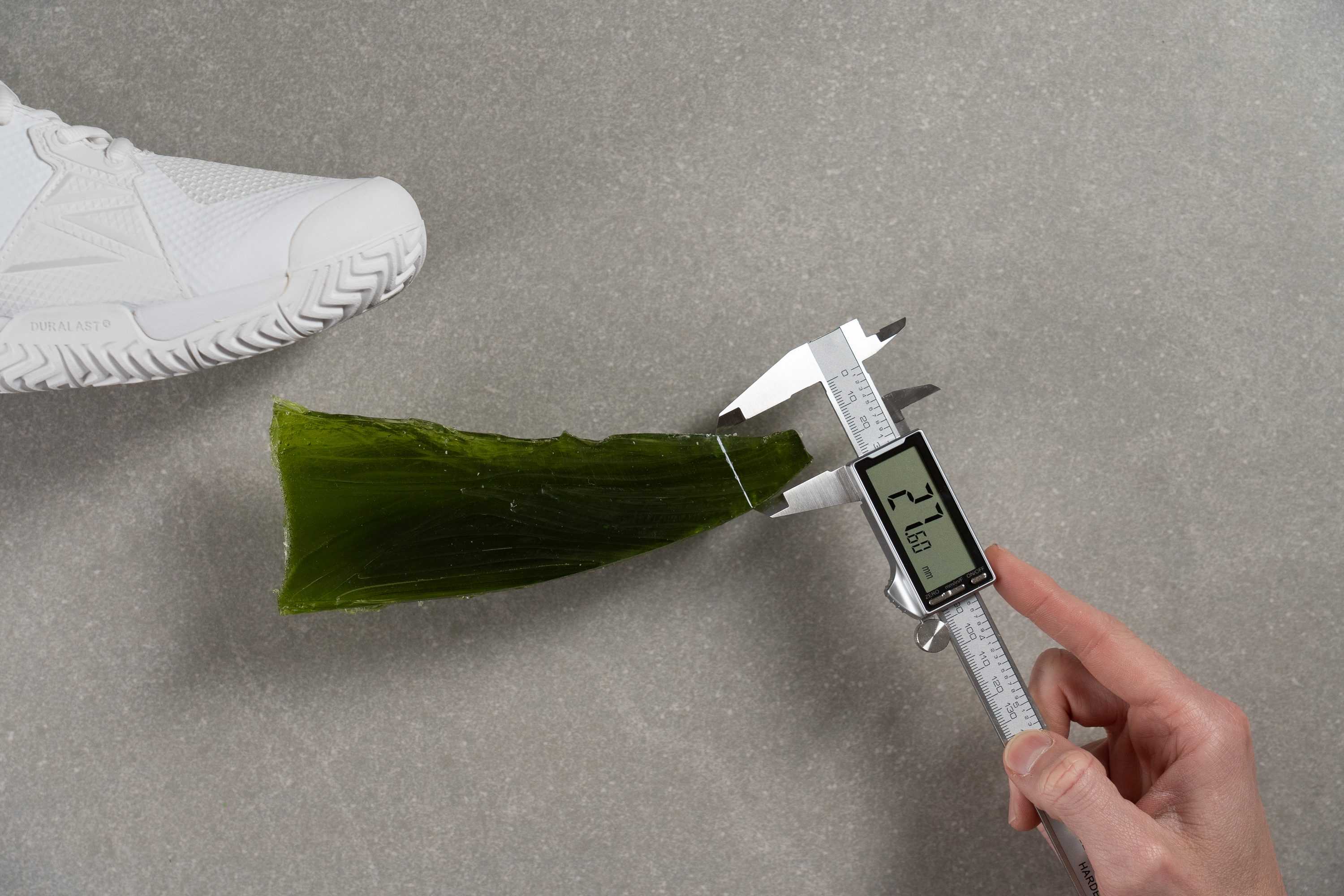
| Rush Pro Ace | 27.6 mm |
| Media | 25.1 mm |
Tracción / Agarre
Tracción en el antepié
Cuando analizamos la tracción de estas zapatillas en el antepié sobre asfalto seco, el resultado fue de 0,77. La verdad es que está bastante bien, ya que consiguieron mantenernos firmes en los cortes rápidos, pero sin dificultar ni los deslizamientos ni los giros.
| Rush Pro Ace | 0.77 |
| Media | 0.76 |
Diseño de la suela exterior
Las Rush Pro Ace tienen un dibujo ondulado en espiga que mezcla líneas gruesas y finitas para que el rendimiento sea versátil en todo tipo de canchas.
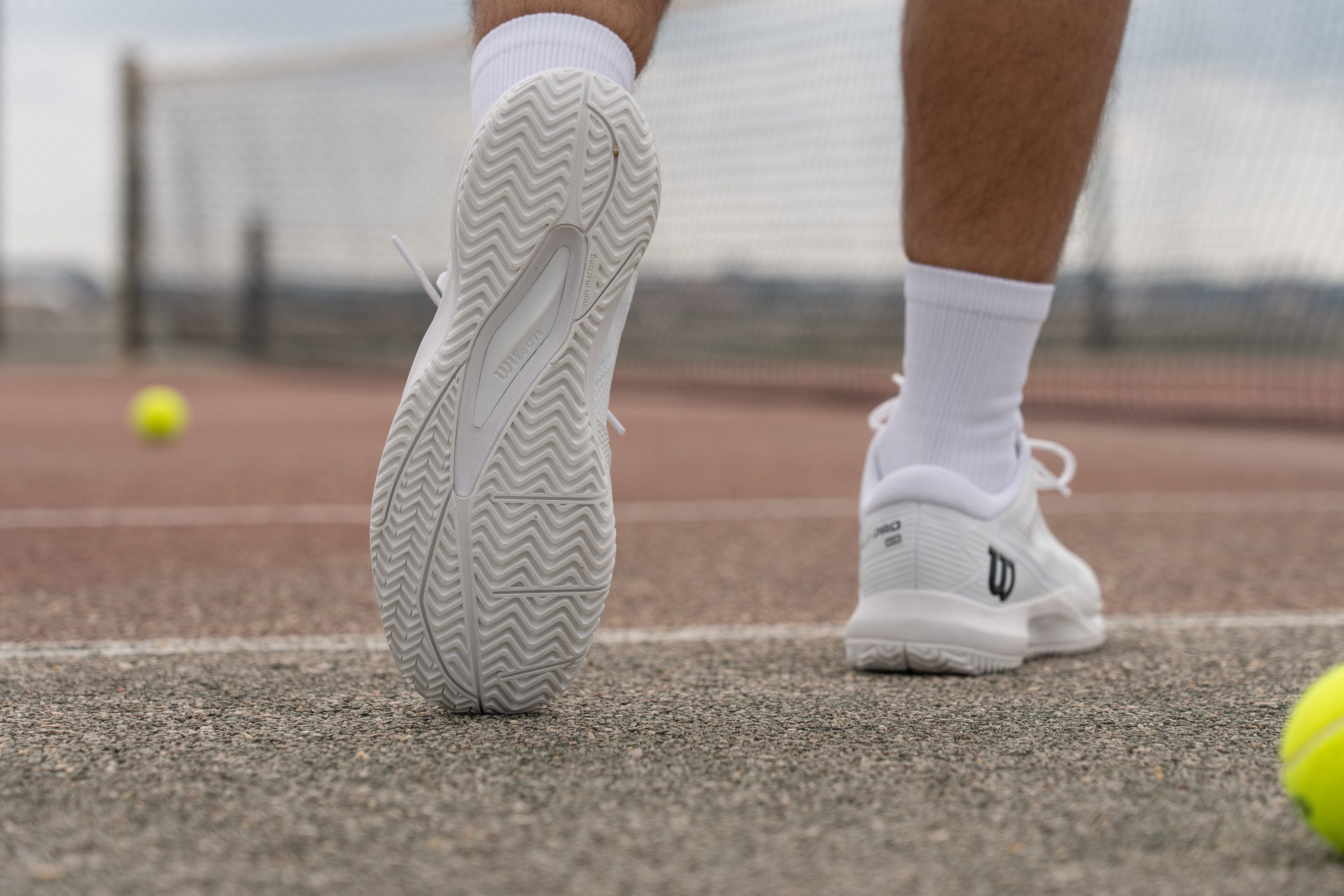
Flexibilidad / Rigidez
Un chasis rígido alrededor de la mediasuela y un cambrillón de plástico en el mediopié limitan la flexibilidad de las Rush Pro Ace, pero como demostró nuestra prueba de flexión, tampoco es que sean las zapatillas más rígidas del mundo.
Necesitamos 16,4 N para doblarlas hasta un ángulo de 30 grados, que es un resultado a la par con la media de la categoría. Esto significa que equilibran flexibilidad (para ser más cómodas) y rigidez (para ofrecerte más impulso). Al final, unas zapatillas que sean muy flexibles no pueden hacer que tus sprints sean rápidos y ágiles.
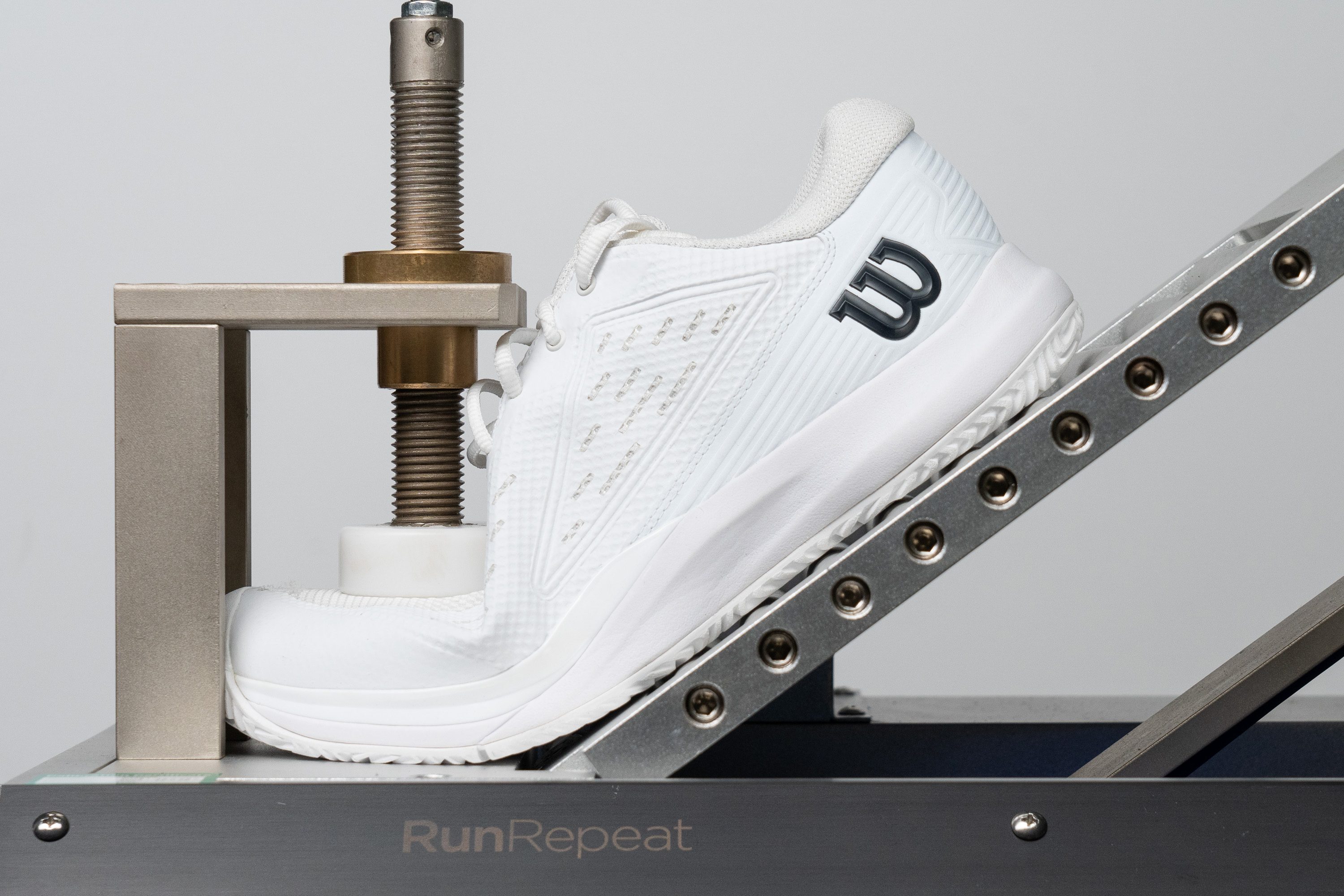
| Rush Pro Ace | 16.4N |
| Media | 16.6N |
Peso
Cuando pusimos las Wilson Rush Pro Ace sobre nuestra báscula, vimos que marcaba un peso estándar de 357 g.
Teniendo en cuenta que el precio de este modelo es moderado, estamos contentos con la cantidad de amortiguación, estabilidad y durabilidad que ofrecen con su peso medio.
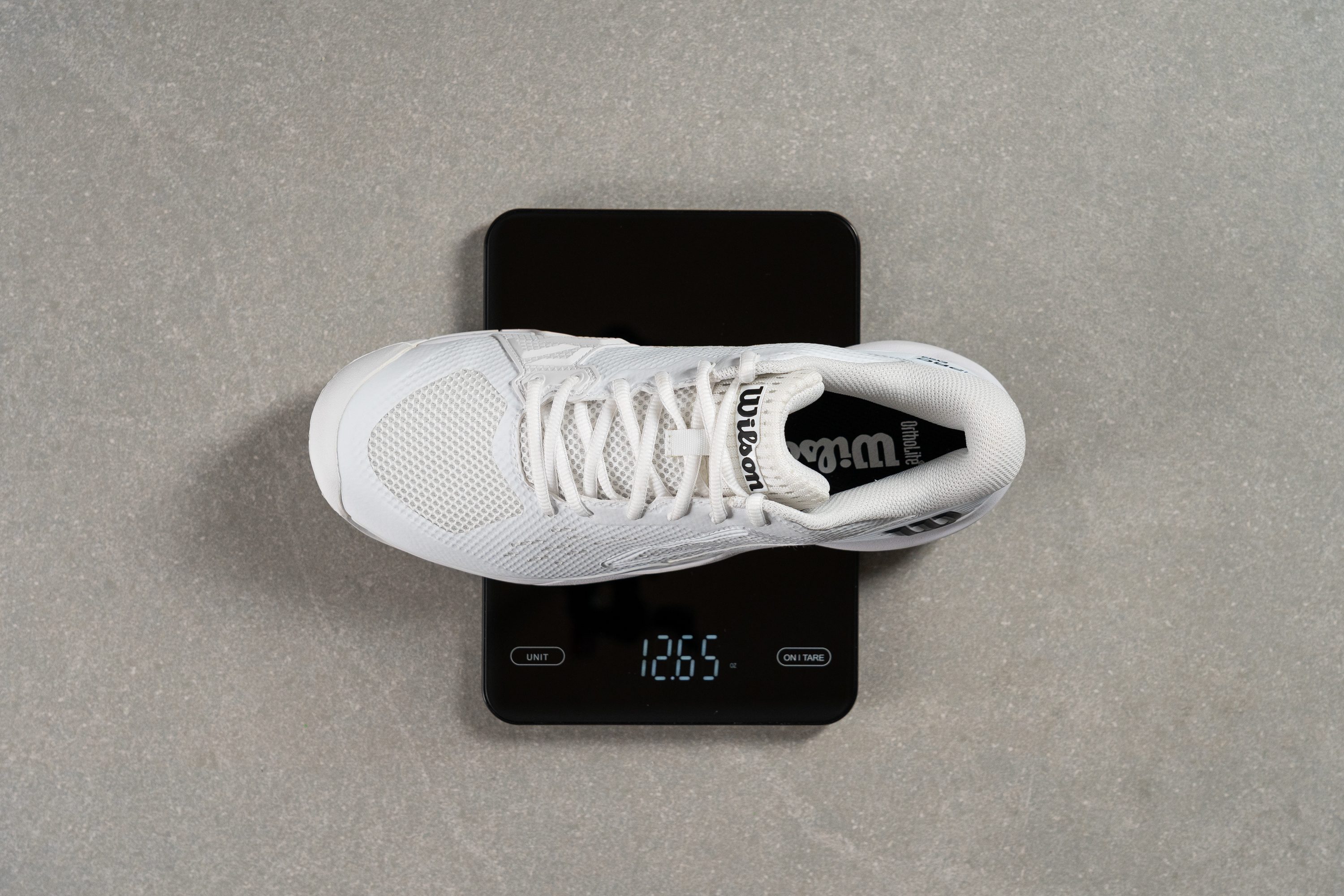
| Rush Pro Ace | 12.6 oz (357g) |
| Media | 12.8 oz (362g) |
Transpirabilidad
Nada más las vimos, ese upper de capas mínimas y bastante transparentes nos hizo pensar que la transpirabilidad de estas zapatillas iba a ser estupenda.
Pero, cuando las sometimos a nuestra prueba de humo, nos dimos cuenta de que nos habíamos equivocado.
La malla de la parte delantera no dejaba que el humo se escapase, así que no pudimos darles más que un 3/5 en esta prueba.
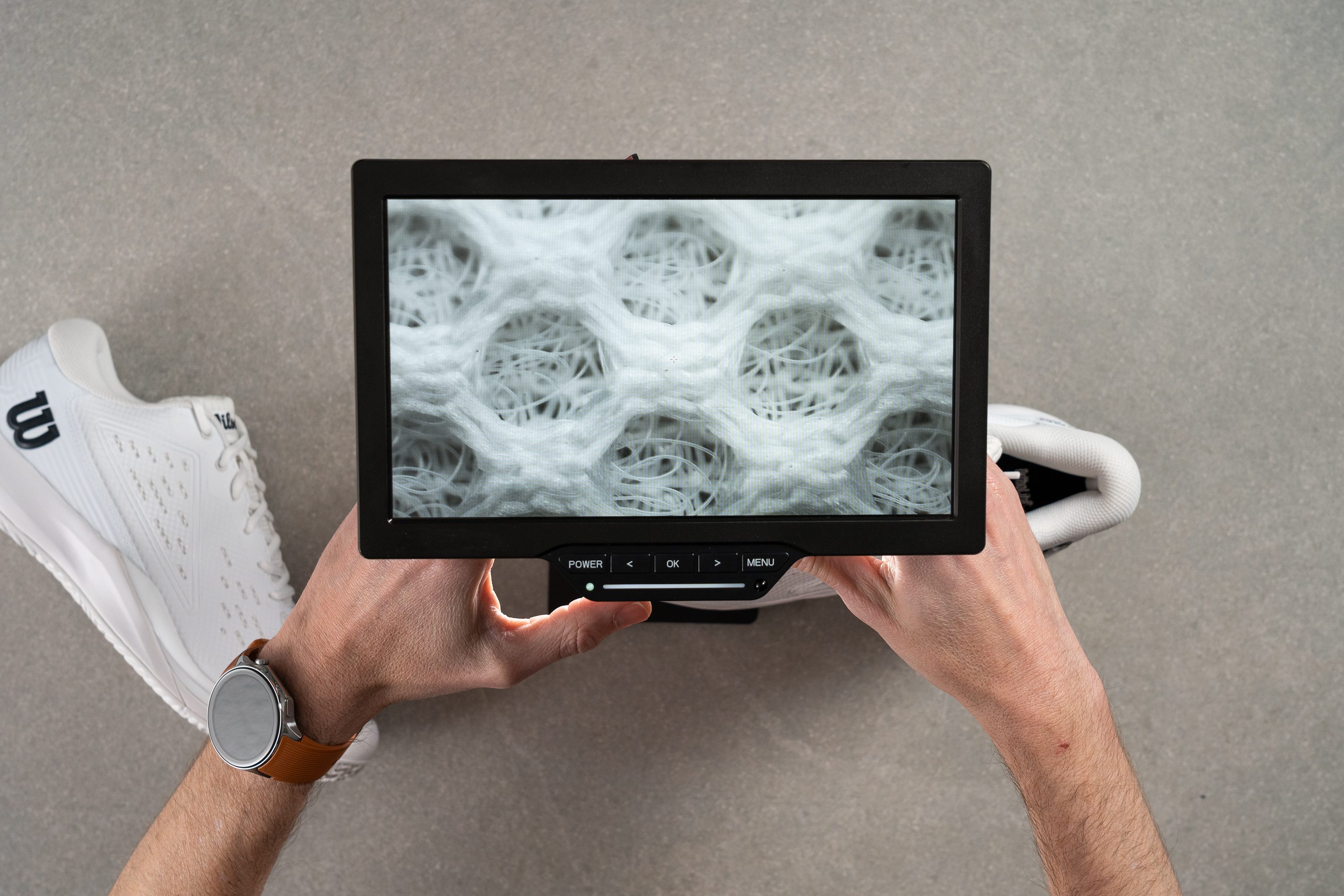
No es el mejor resultado que hemos visto, pero lo bueno es que la malla porosa de que tienen evita que las zapatillas se calienten demasiado. Los canales de aire tan pequeñitos que tienen en el upper trabajan codo con codo para que estas Wilson tengan un flujo de aire lo suficientemente bueno.
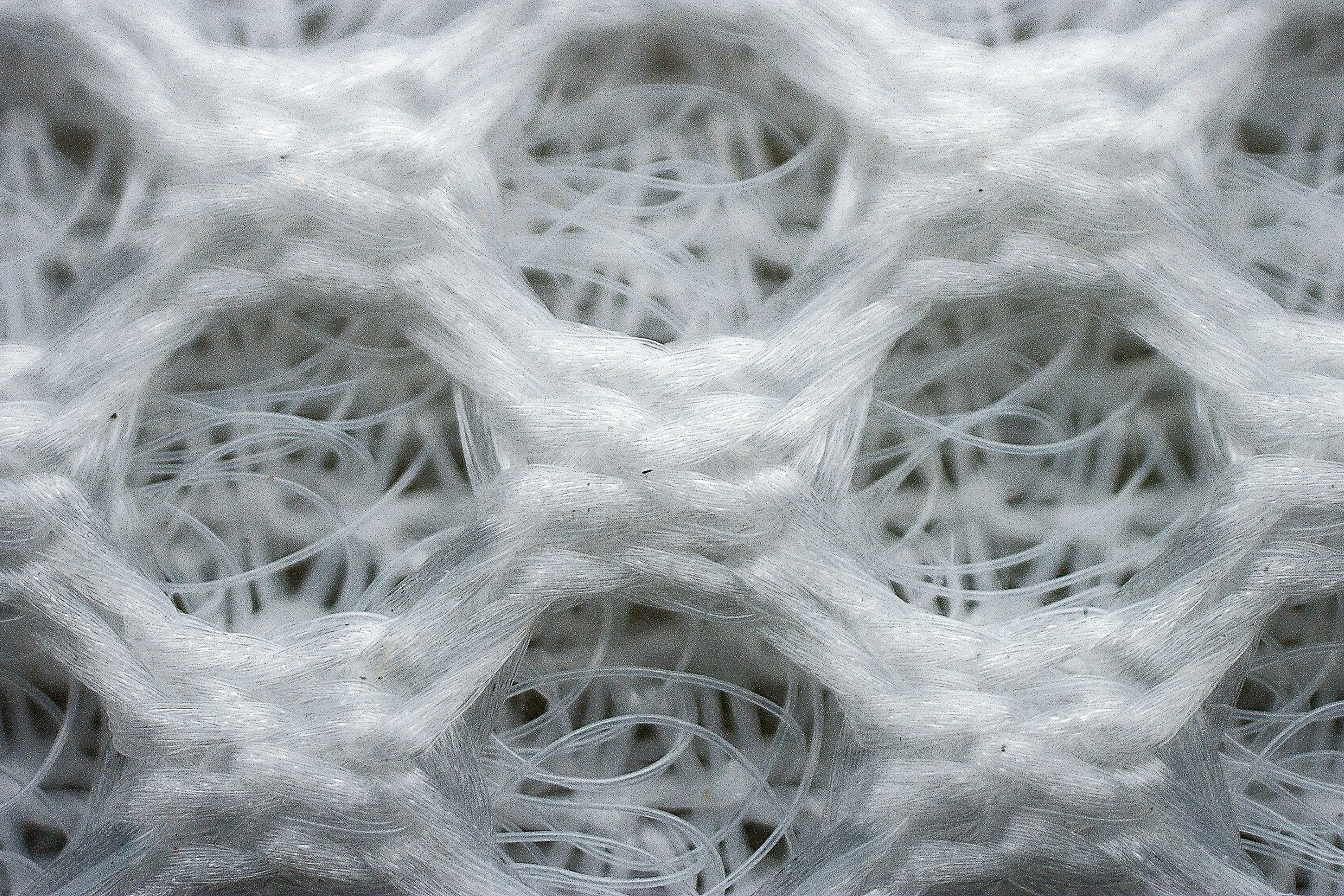
| Rush Pro Ace | 3 |
| Media | 3.2 |
Estabilidad
Prueba de estabilidad lateral
Las Rush Pro Ace tienen una variante del 4D Support Chassis de la marca para garantizar una pisada estable en la pista. Visualmente, se parecen mucho al chasis 2.0 de las Rush Pro 4.0, que es más avanzado, pero hay una diferencia importante en la forma y en la colocación de los componentes de sujeción.
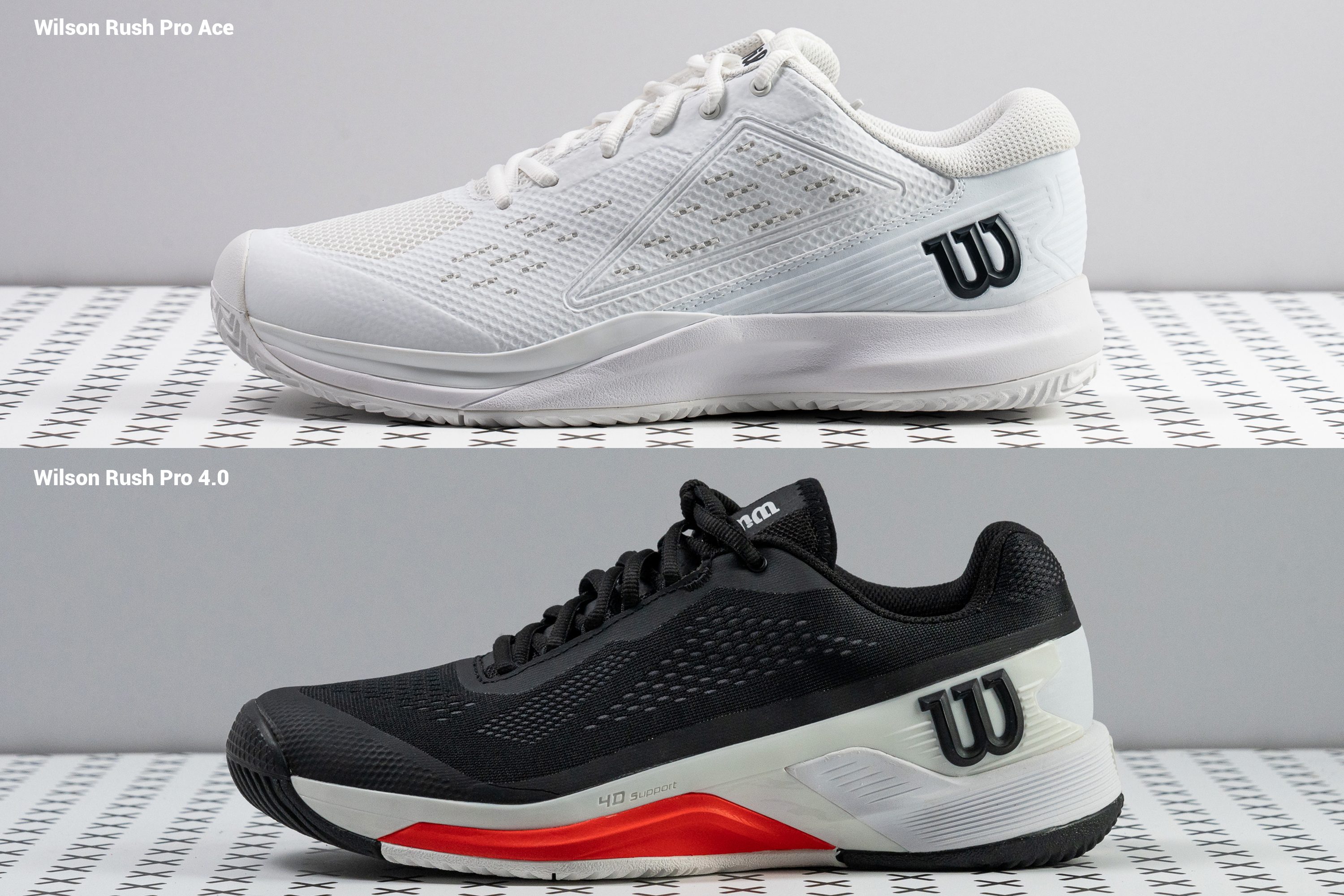
Después de haberles hecho pruebas a ambos modelos en las mismas condiciones, estamos encantados de poder decirte que la diferencia en rendimiento casi no se nota. Lo que sí que sentimos era que el contrafuerte del talón de las Rush Pro es un poco más rígido, pero hasta ahí.
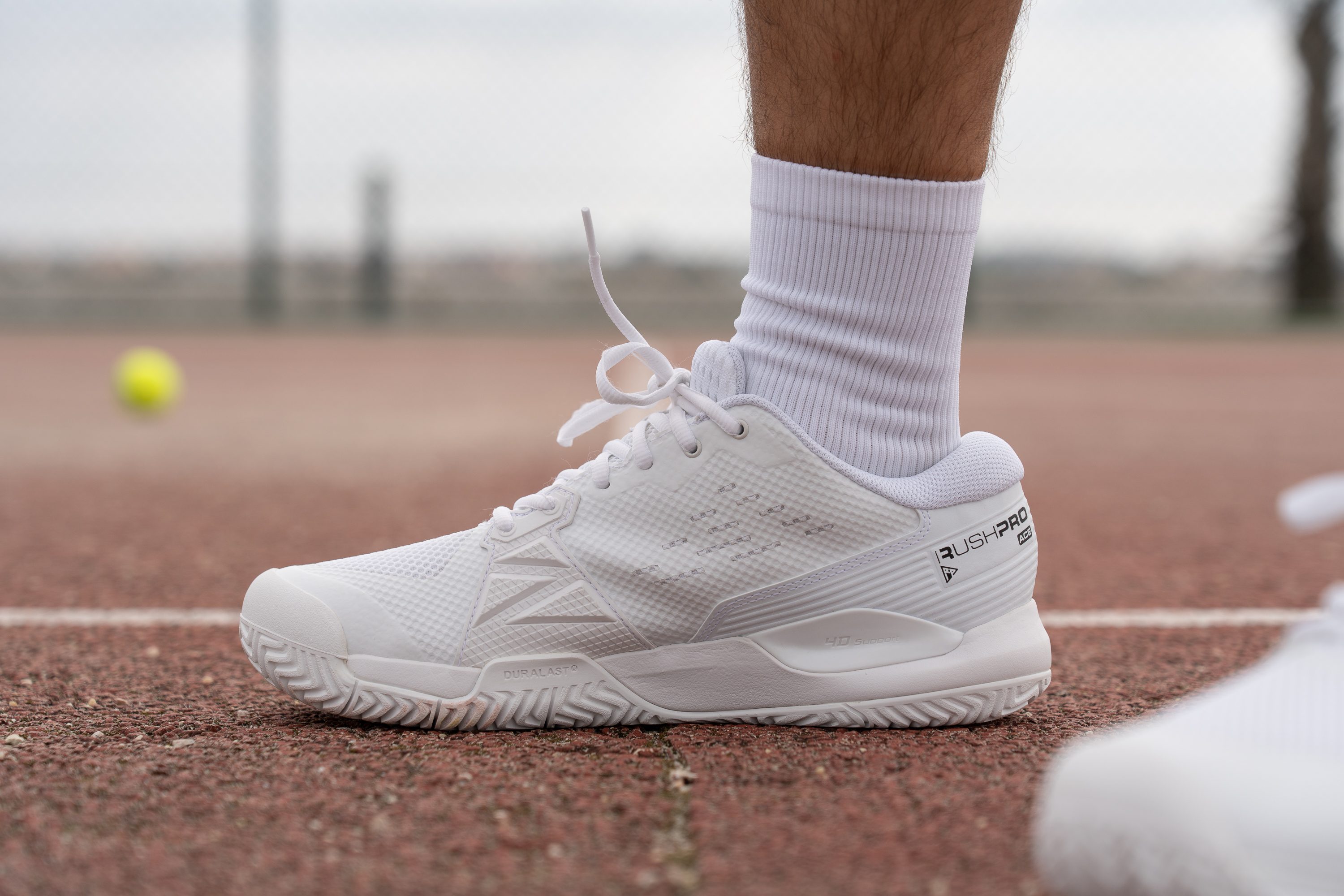
Como puedes ver en la foto de arriba, el chasis de las zapatillas es distinto en la cara interna que en la externa. Este diseño asimétrico ayuda a evitar que el pie se incline tanto hacia dentro (sobrepronación) como hacia fuera (supinación/subpronación).
Vamos, que sentimos que podíamos confiar en la sujeción de las Ace incluso en los movimientos laterales más llenos de energía durante nuestras pruebas de uso jugando con ellas.
Rigidez torsional
A ver, claramente el 4D Chassis le añadió mucha rigidez a estas zapatillas, ya que casi no cedieron en nuestra prueba manual.
En una escala de rigidez del 1 al 5, en la que 5 significa que no ceden en absoluto, las Wilson Rush Pro Ace se llevaron un 4. Están un poco por detrás de las reinas de la estabilidad como las ASICS Gel Resolution o las Adidas Barricade, pero justo por eso son más cómodas, por la flexibilidad moderada que ofrecen y por su estructura más ligera.
Y no olvidemos que las Rush Pro Ace tampoco están en el mismo rango de precios.
| Rush Pro Ace | 4 |
| Media | 4.4 |
Rigidez del contrafuerte del talón
El contrafuerte del talón se llevó otra puntuación alta en rigidez: un 4/5. Aunque no es la más alta, el cierre nos pareció muy seguro tanto en el talón como en el tobillo.
Todo ese acolchado alrededor del cuello envuelve muy bien nuestros talones.
| Rush Pro Ace | 4 |
| Media | 4.1 |
Anchura de la mediasuela - antepié
Al igual que las Rush Pro 4.0, las Rush Pro Ace tiene una plataforma con una anchura bastante moderada. Si tuviésemos que describirla antes con palabras que con números, diríamos que de ancha tiene "lo justo".
La extensión de la suela en el antepié no es la más grande que hemos visto, pero la anchura en esta zona consigue llegar a la media con sus 110,5 mm. Esto hace que la plataforma para aterrizar sea suficiente para que el pie frene bien y se impulse si necesitamos movernos rápido.
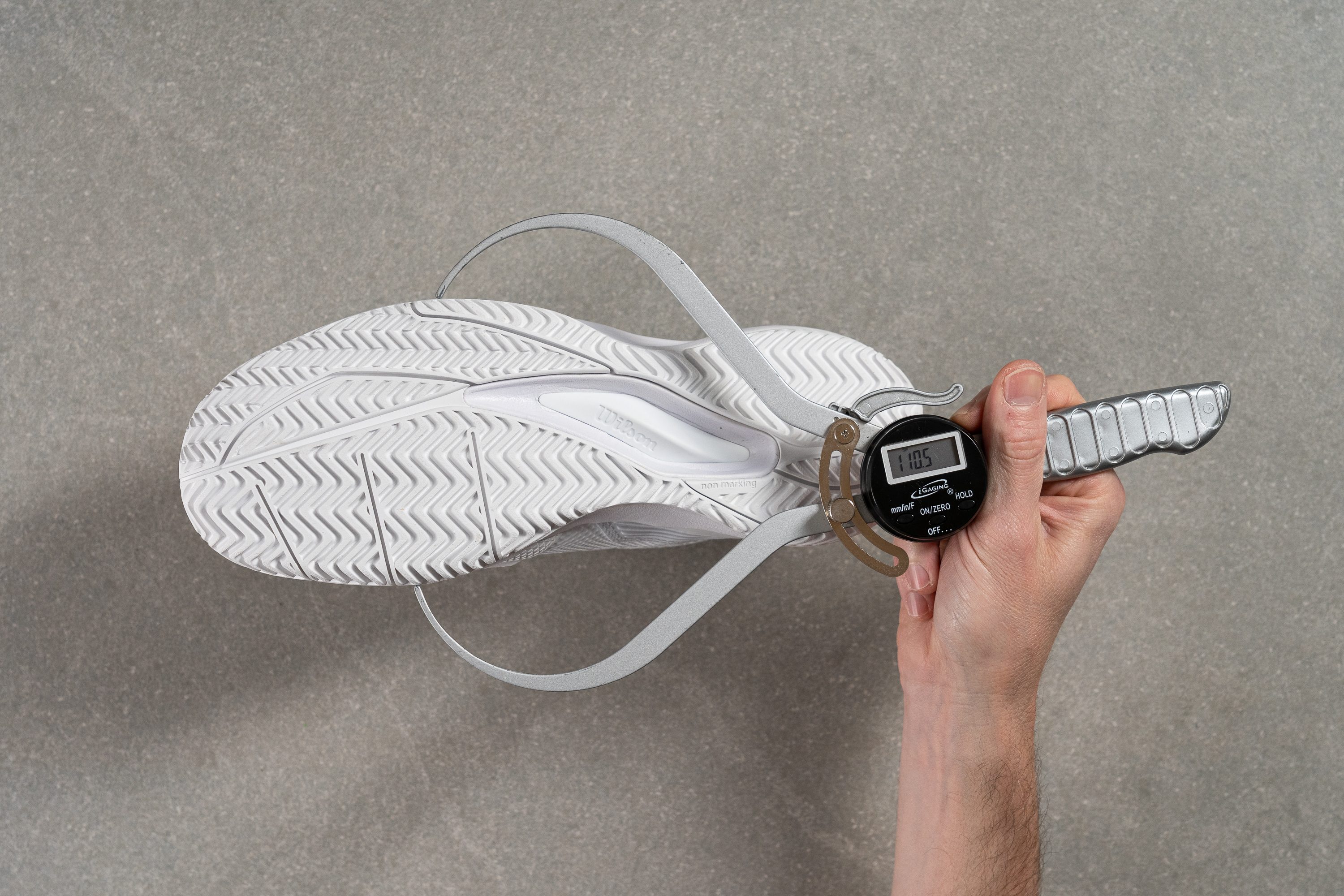
| Rush Pro Ace | 110.5 mm |
| Media | 111.9 mm |
Anchura de la mediasuela - talón
Podemos decir lo mismo de la anchura en el talón.
Con 87,2 mm en su parte más ancha, la suela es incluso un poco más estrecha que la media. Por lo tanto, si eres de los que les gusta moverse pro la línea de fondo, puede que prefieras unas zapatillas de tenis con un poco más de suela en la que apoyarte.
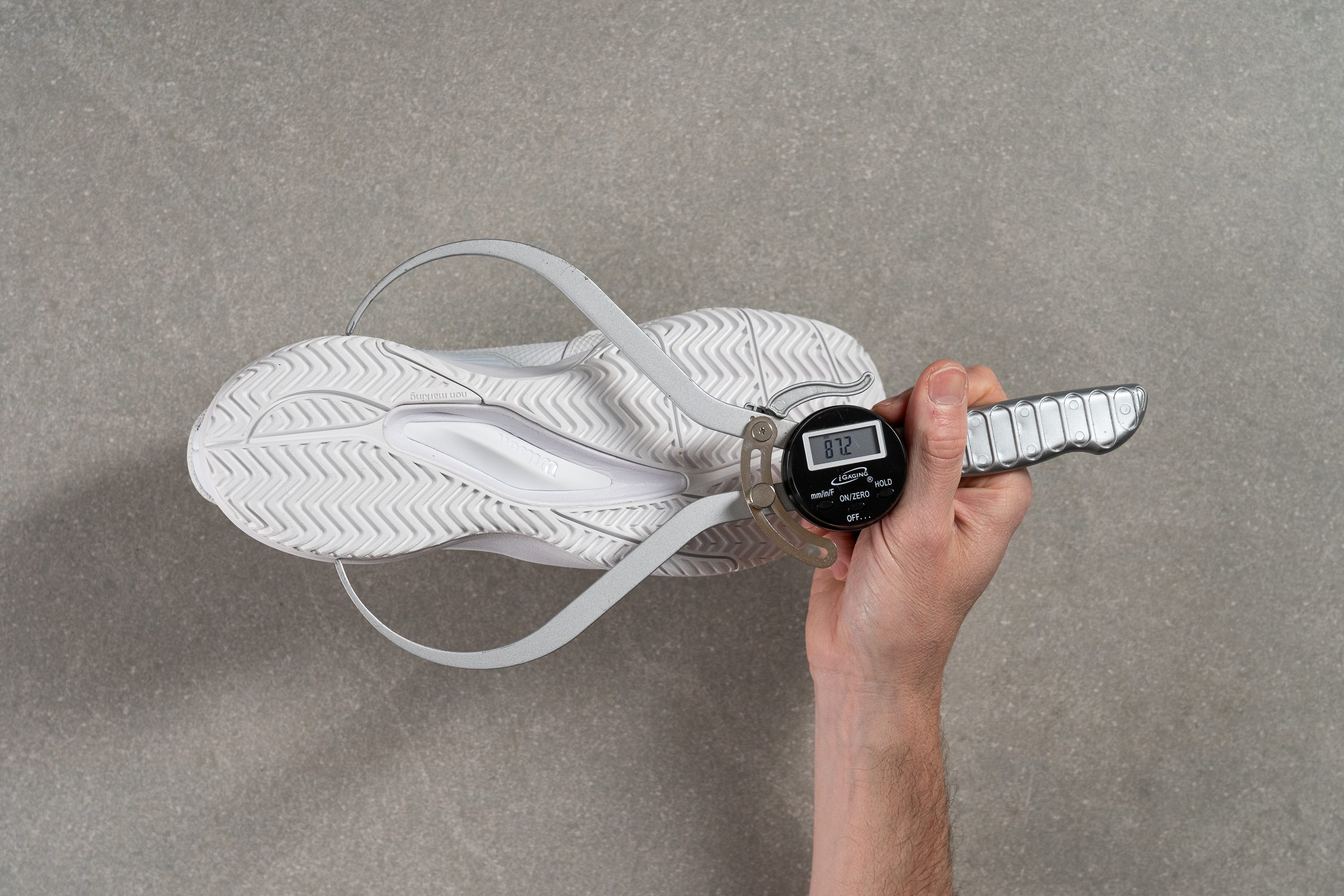
| Rush Pro Ace | 87.2 mm |
| Media | 89.6 mm |
Durabilidad
Durabilidad de la protección delantera
Estamos encantados de poder decirte que las Rush Pro Ace no han escatimado en la durabilidad del protector de la zona de los dedos. De hecho, sus características son parecidas a las de las Rush Pro 4.0, un modelo más caro.
Esta pieza de caucho tiene triángulos convexos para aumentar la resistencia al desgaste y protege el upper de las zapatillas de las abrasiones en los deslizamientos y del arrastre de los dedos en la pista.
Para imitar esto último, cogimos nuestro Dremel y le dimos caña a 10K RPM. Como puedes ver, ¡casi no llegamos ni a la mitad del caucho! Vamos, que estas zapatillas se llevaron un 4/5 en durabilidad de la parte delantera.
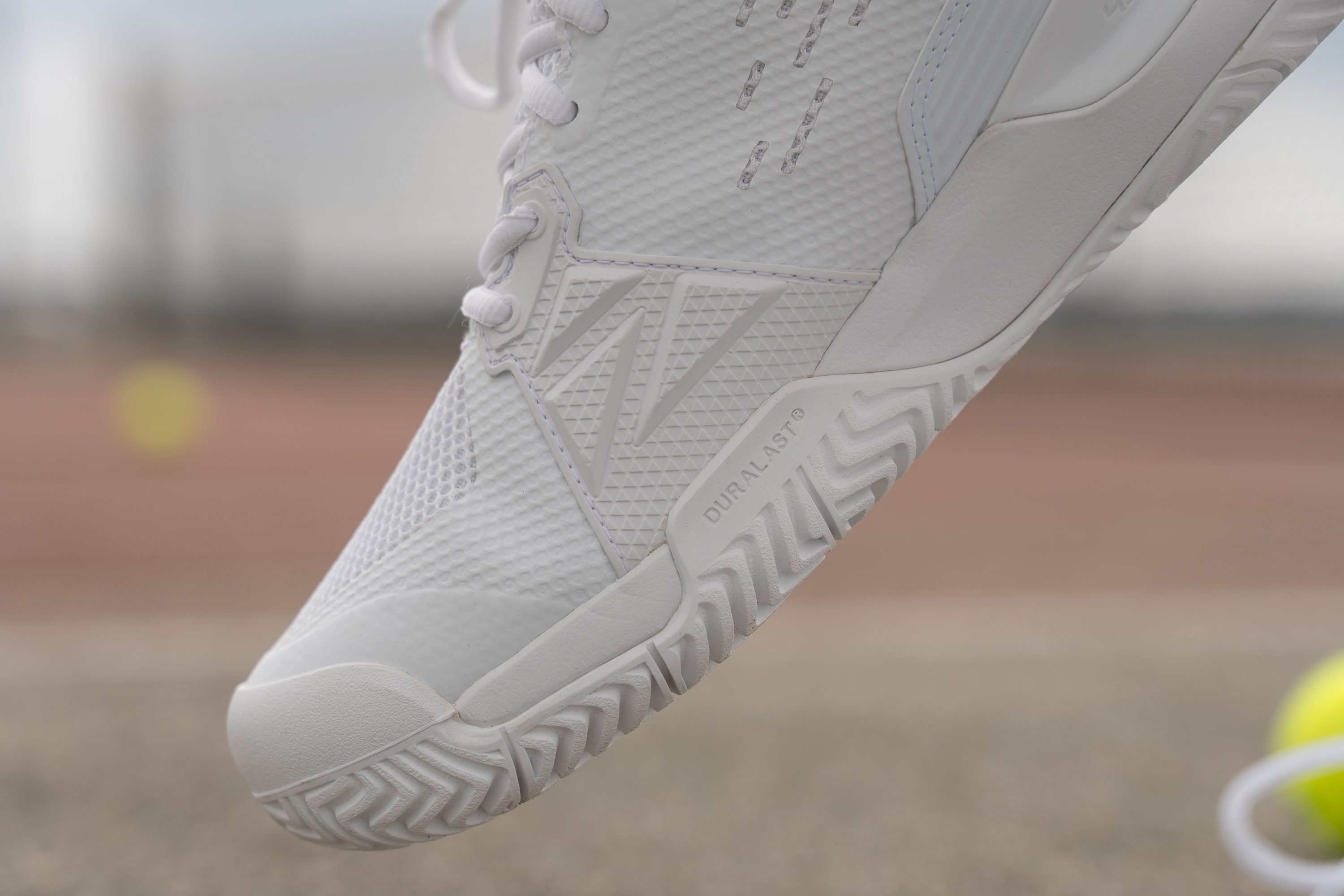
Por otro lado, la suela exterior de caucho Duralast se extiende hacia arriba para proteger la parte de abajo de las zapatillas, que es propensa a la abrasión.
| Rush Pro Ace | 4 |
| Media | 3.3 |
Durabilidad de la parte delantera
Esa malla que tienen parece y se siente frágil, así que nos alegramos de ver algunos refuerzos sintéticos alrededor de la zona de los dedos de las Rush Pro Ace.
Como demostró nuestra prueba con el Dremel, estas protecciones ayudaron a proteger las zapatillas, así que se llevaron un 3/5 en nuestra prueba de durabilidad de la parte delantera.
| Rush Pro Ace | 3 |
| Media | 3.7 |
Durabilidad del acolchado del talón
Lo malo es que el forro de malla del interior del cuello de estas zapatillas no es tan resistente al desgaste como la malla exterior. No tardamos ni 4 segundos en hacerle un agujero y, por lo tanto, no pudimos darle más que un 2/5 en durabilidad a esta zona.
Si te preocupa terminar agujereando el interior de tus zapatillas de tenis antes de tiempo, a lo mejor prefieres echarle un ojo a las Adidas Gamecourt 2.0 o a las K-Swiss Hypercourt Express 2.
| Rush Pro Ace | 2 |
| Media | 3.3 |
Dureza de la suela
Puede que las Rush Pro Ace sean unas zapatillas baratas, pero su suela exterior Duralast no lo es en absoluto.
Cuando medimos su densidad en el laboratorio, nuestro durómetro marcó 85,5 HC, un resultado muy alto. Esto confirma su reputación como caucho de alta densidad, y es que es tan duro como la media de las suelas exteriores de las zapatillas de tenis.
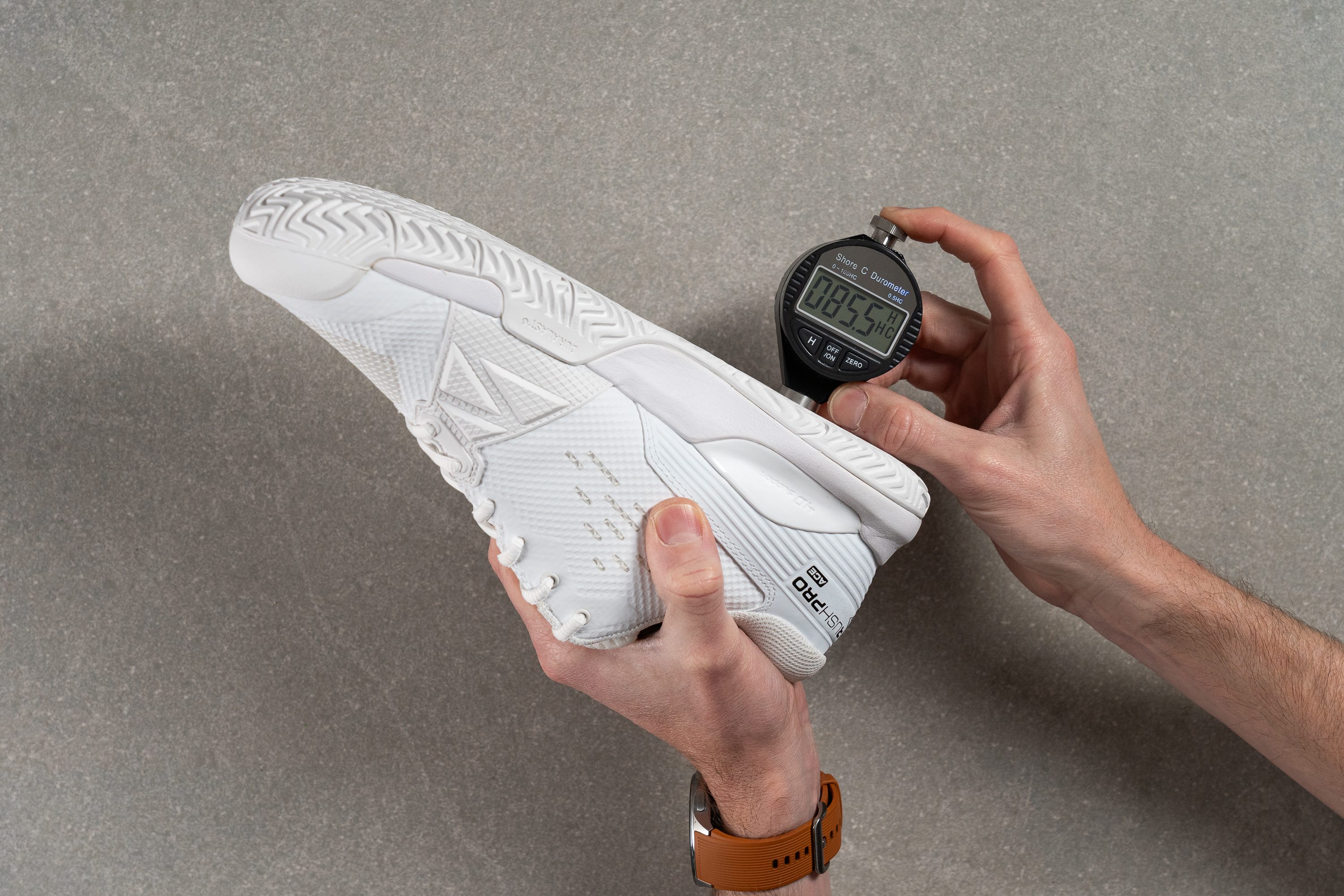
| Rush Pro Ace | 85.5 HC |
| Media | 86.0 HC |
Durabilidad de la suela
Además, este compuesto de caucho demostró su valía en nuestra prueba Dremel.
Después de exponerlo al Dremel durante 18 segundos a una velocidad de 10K RPM, mostró menos de 1 mm de daño (0,8 mm para ser exactos), que es lo que solemos ver en las zapatillas de tenis más caras.
| Rush Pro Ace | 0.8 mm |
| Media | 0.8 mm |
Grosor de la suela
El grosor de la suela exterior es de 3,8 mm, y también nos pareció suficiente. Es una cantidad de caucho sólida para unas zapatillas para pista dura, así que deberían aguantarte bien un tiempo razonable.
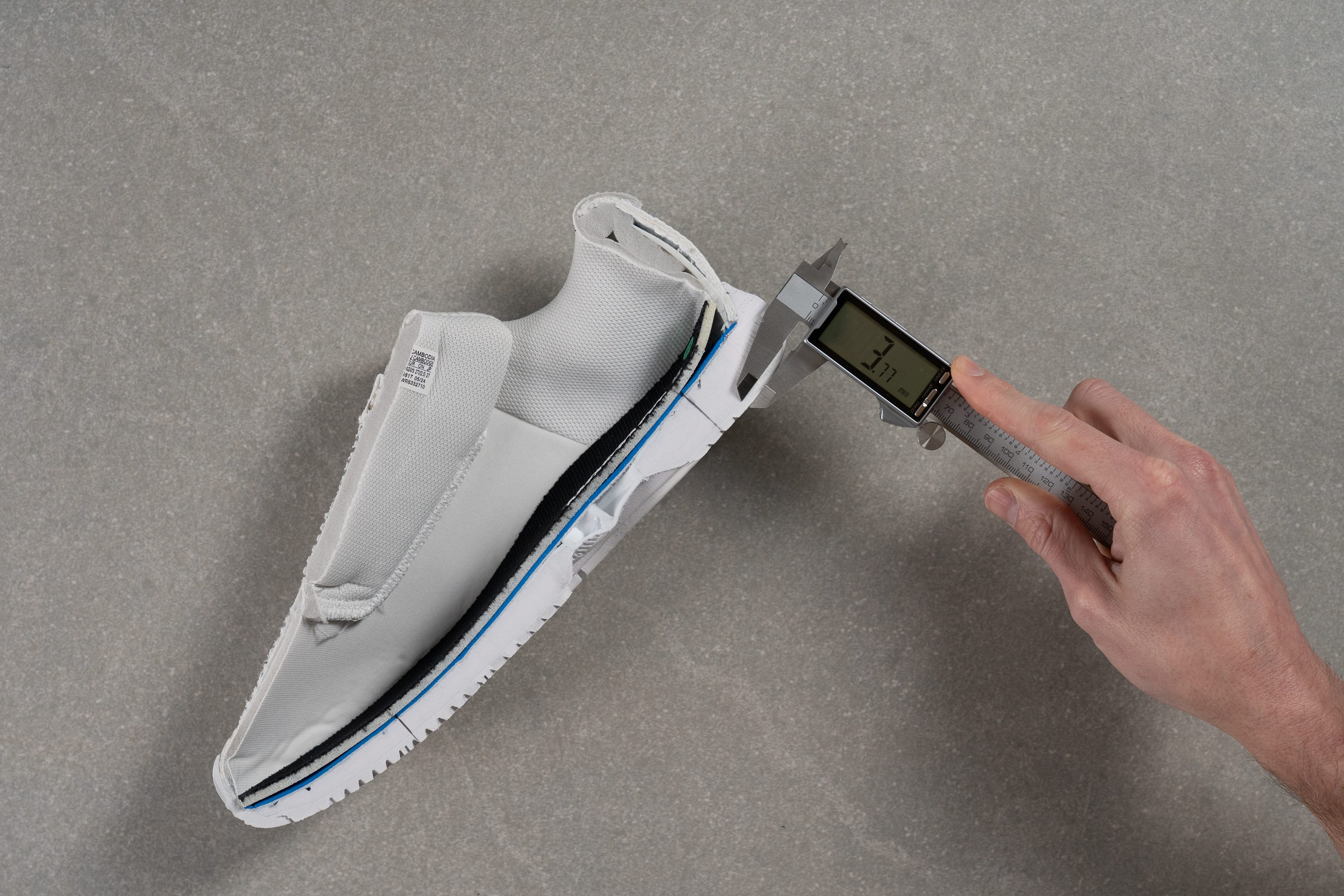
| Rush Pro Ace | 3.8 mm |
| Media | 4.2 mm |
Varios
Grosor de la plantilla
El toque final a la amortiguación bajo los pies se lo da una plantilla OrthoLite moldeada y bastante cómoda.
La marca la describe como una espuma de alta densidad que ofrece una amortiguación máxima. Aunque estamos de acuerdo con lo primero (la plantilla es más fina que la media, con sus 4,0 mm), no estamos tan seguros de lo segundo (tampoco es que añada muchísima amortiguación extra).
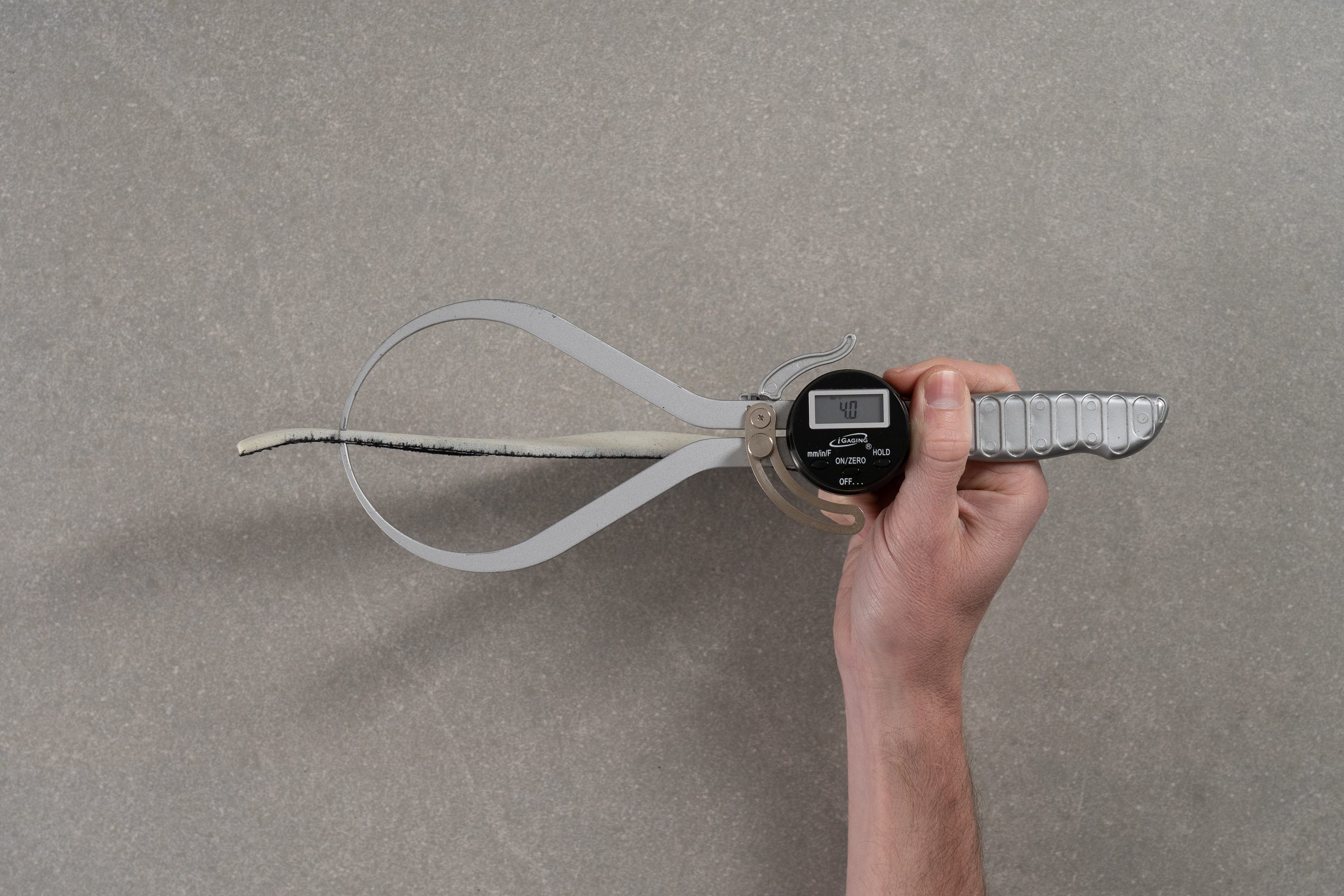
| Rush Pro Ace | 4.0 mm |
| Media | 5.1 mm |
Plantilla extraíble
Estas zapatillas utilizan una plantilla OrthoLite bastante cómoda, pero la puedes cambiar por otra si quieres o si lo necesitas, no te pondrán problema.
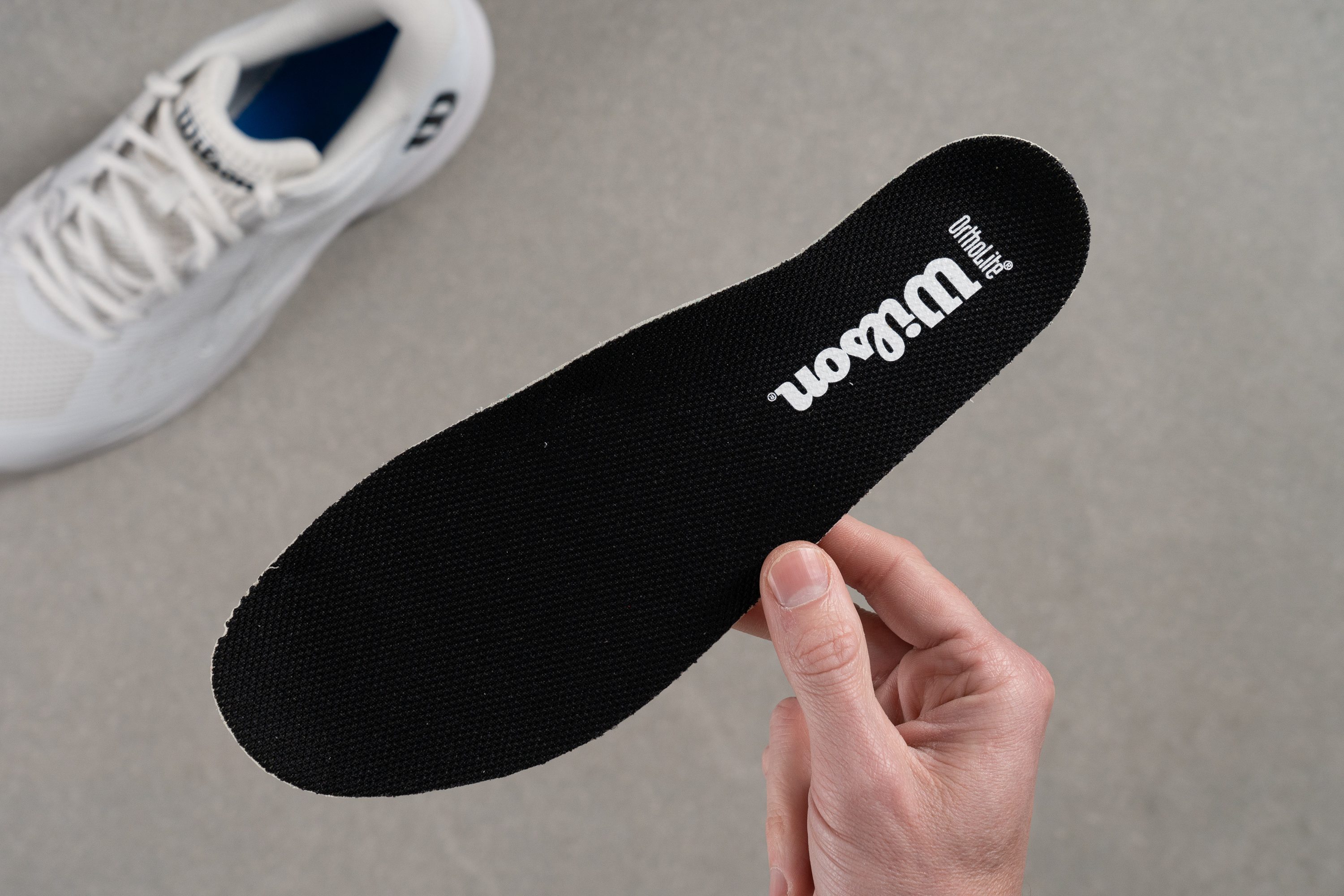
| Rush Pro Ace | Sí |
Acolchado de la lengüeta
Una de las cosas que notas inmediatamente al ponerte las Rush Pro Ace es lo generosamente acolchados que están sus interiores.
Más en concreto, cuando medimos el grosor de la lengüeta, nuestro calibre marcó un resultado superior a la media: 11,9 mm. Es una de las lengüetas más grandotas que hemos visto en unas zapatillas de tenis.
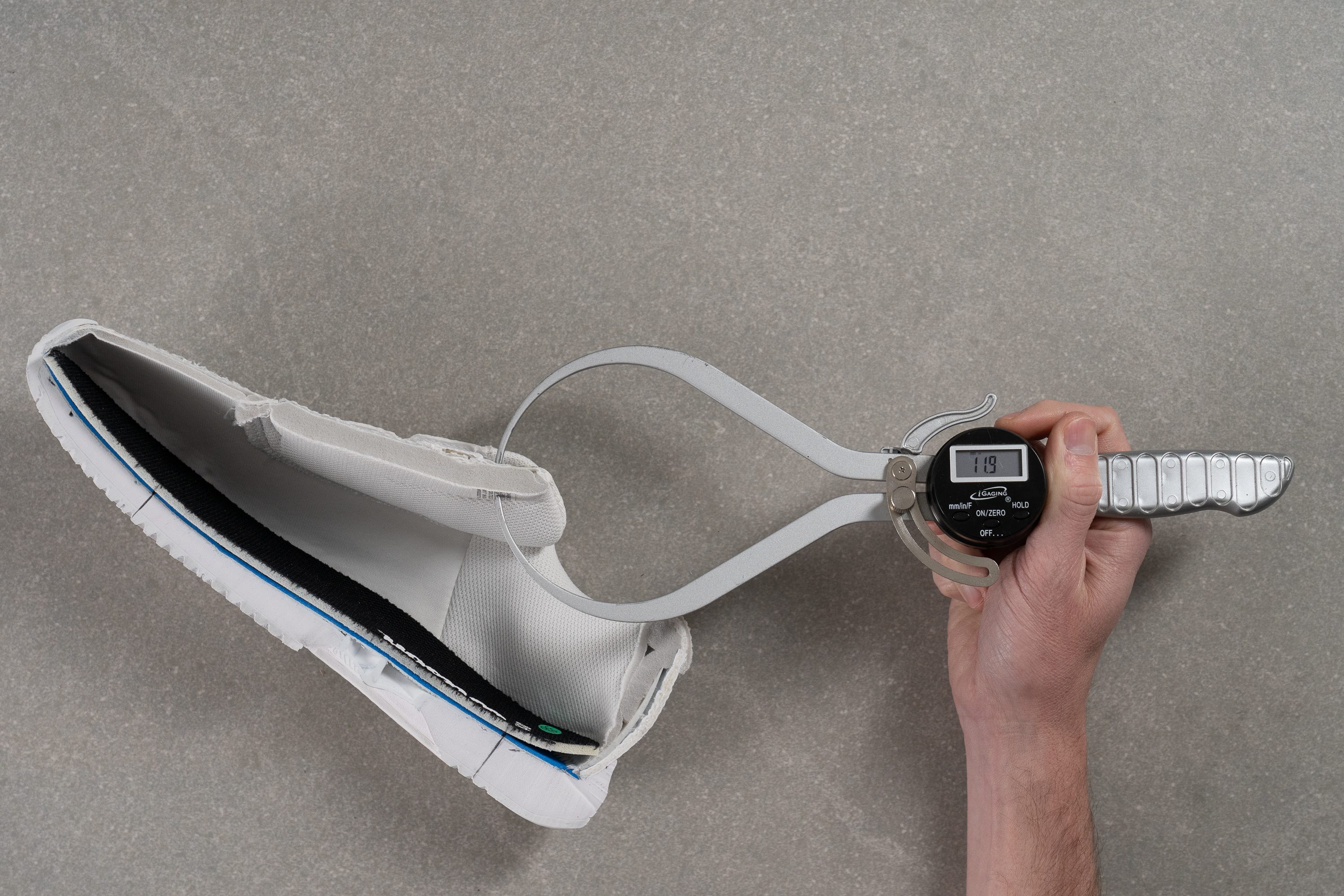
| Rush Pro Ace | 11.9 mm |
| Media | 8.1 mm |
Lengüeta: tipo de refuerzo
Los refuerzos de la lengüeta son algo que siempre echamos de menos en las zapatillas de tenis más asequibles. Como estas tampoco tienen, a lo mejor su lengüeta se mueve un poco.

| Rush Pro Ace | Ninguno |
Precio
Wilson ofrece una fantástica relación calidad-precio en muchos aspectos. Aunque las Rush Pro Ace entran en la categoría de zapatillas de tenis asequibles, ¡no tienen nada de baratas!
Son cómodas, duraderas y ofrecen sujeción, superando con su calidad a algunas de las opciones más caras.
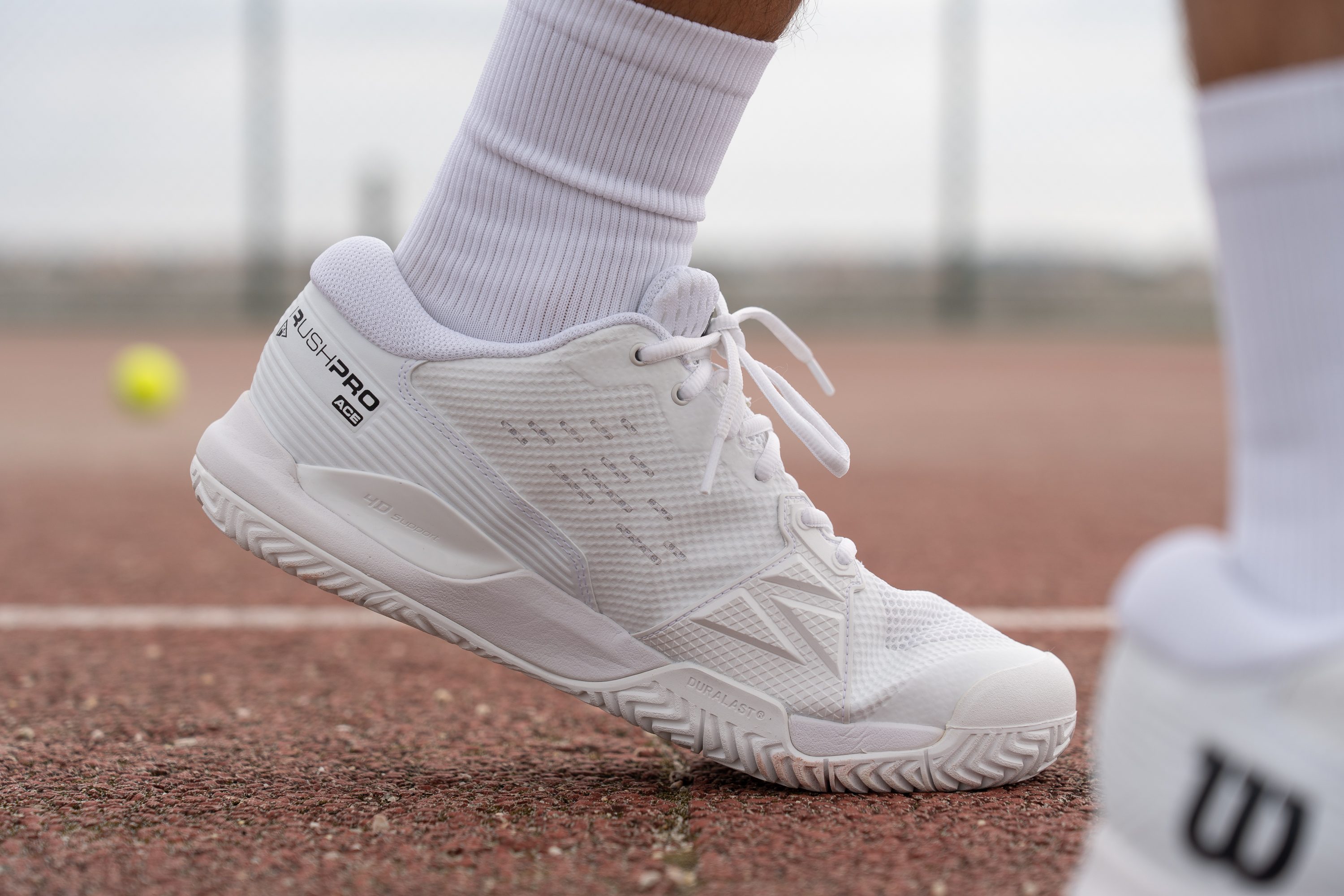
| Rush Pro Ace | $100 |
Tirador del talón
El diseño del contrafuerte del talón de estas zapatillas deja que te las pongas sin problema. Por eso no necesitas ni tiradores ni nada que te eche una mano para calzarte.
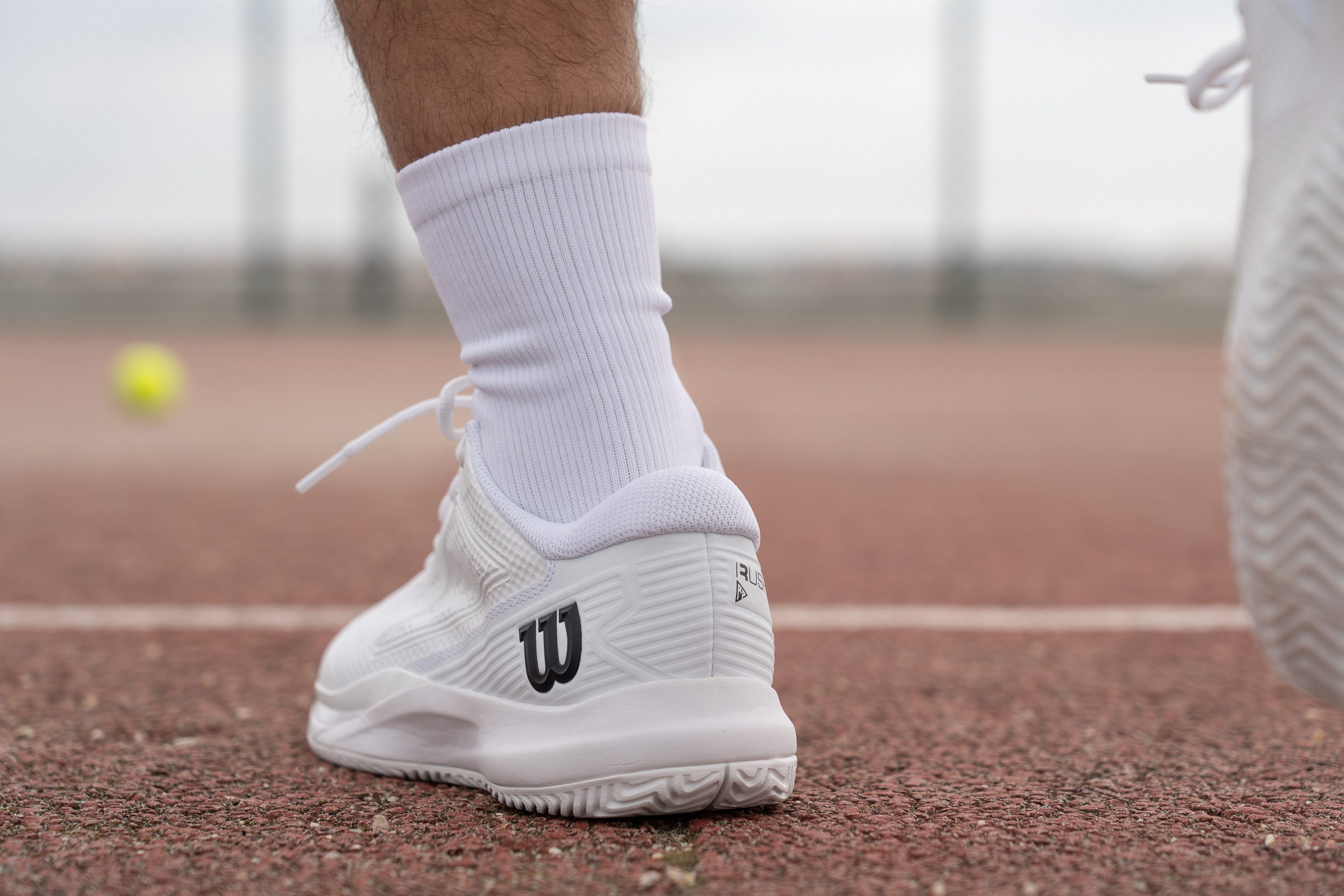
| Rush Pro Ace | Ninguno |
Cordones
Estas Wilson utilizan cordones bastante básicos, pero cumplen su función. El único problema es que no están protegidos, así que los movimientos bruscos en la pista a lo mejor los terminan dañando.
